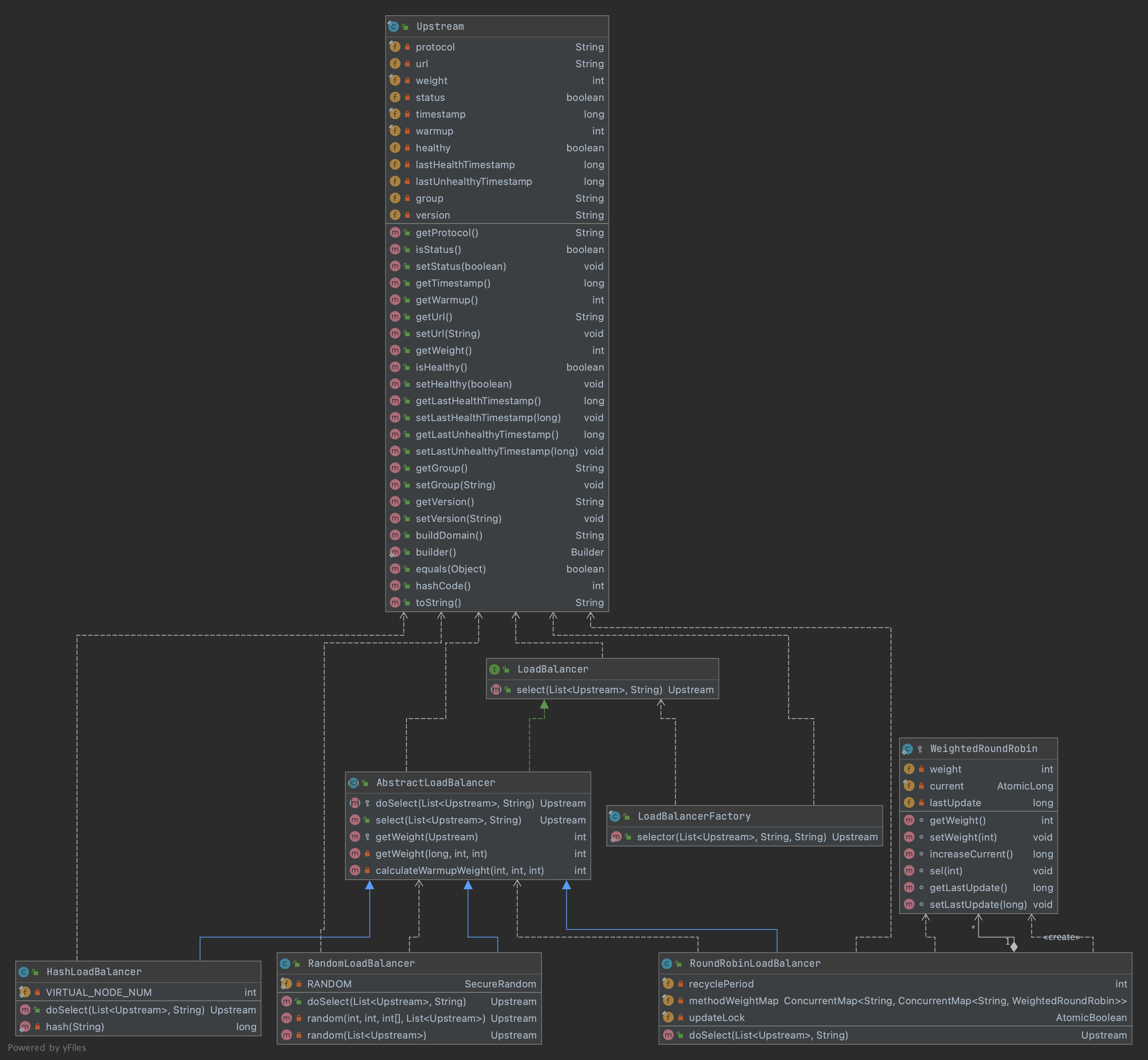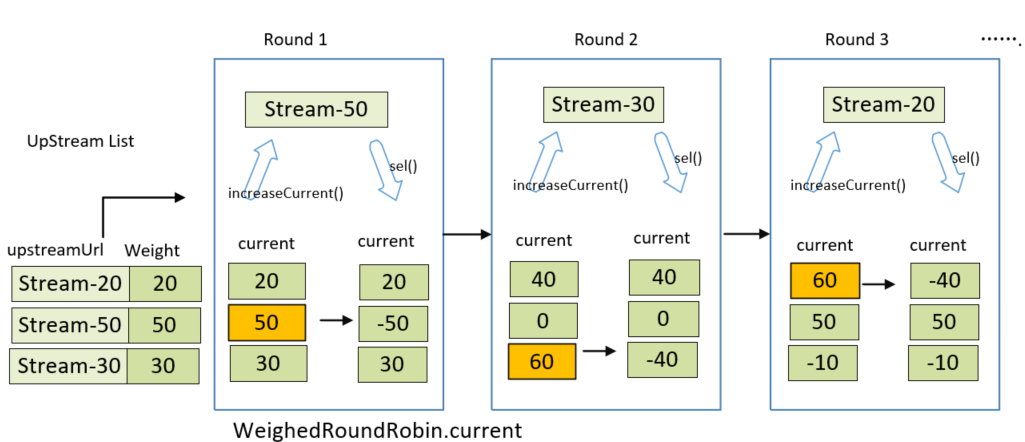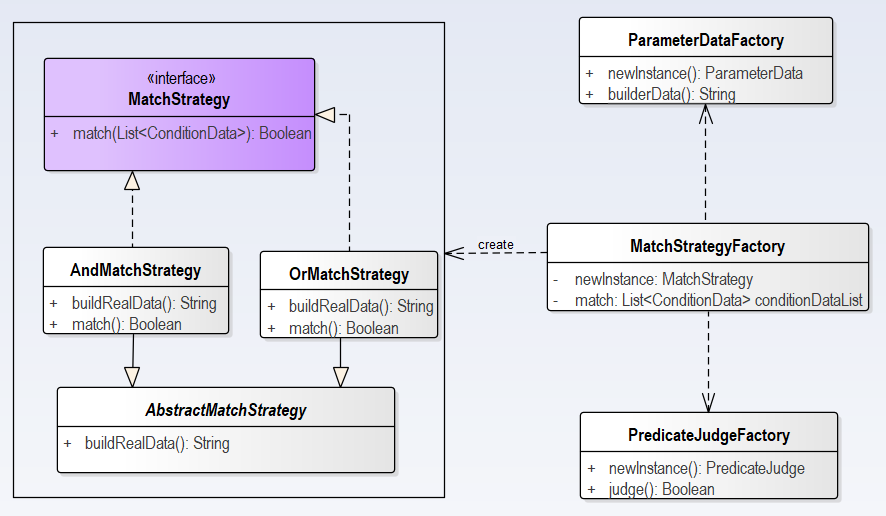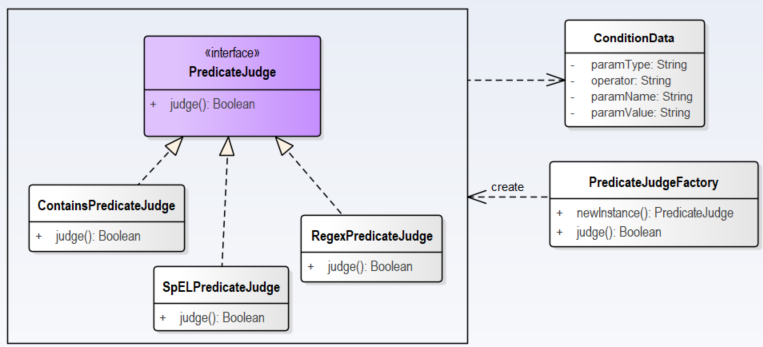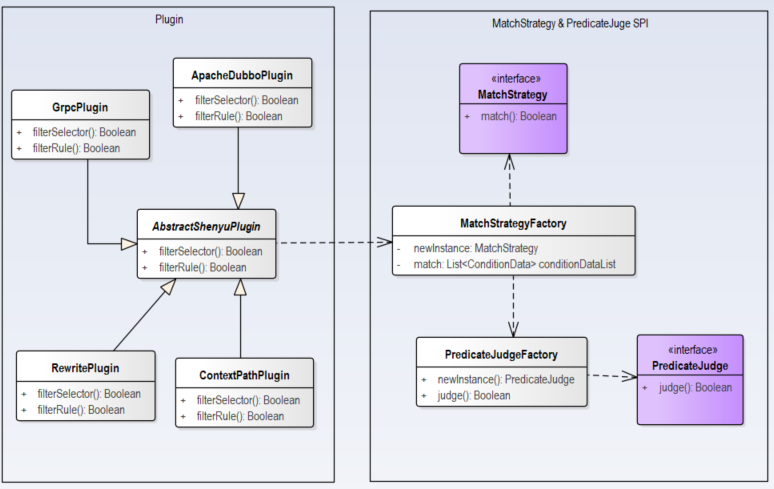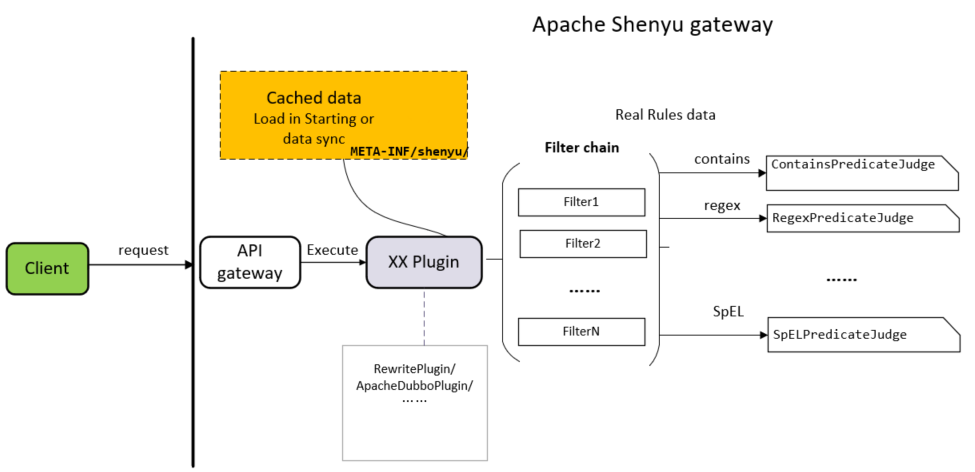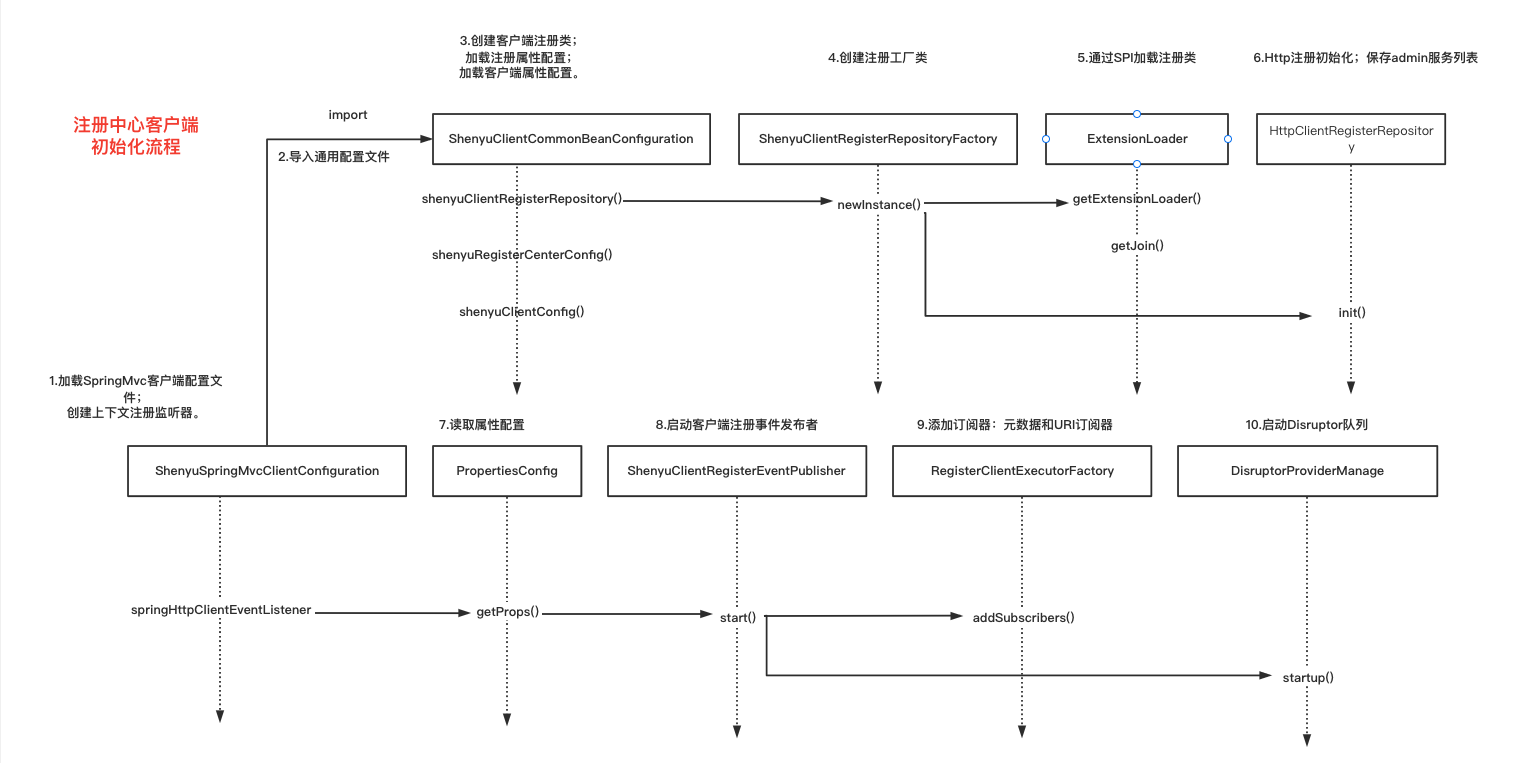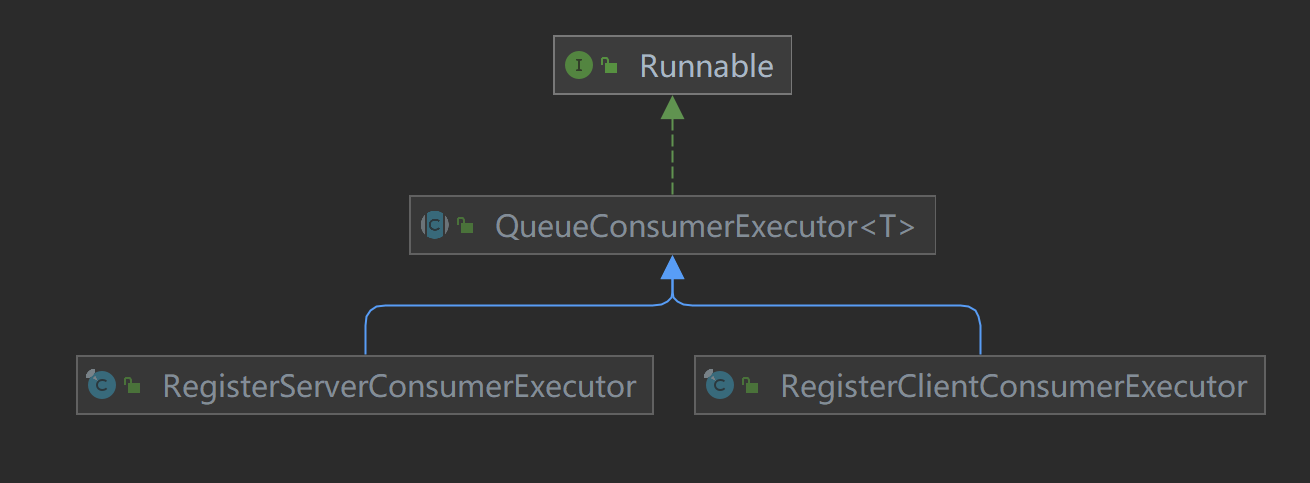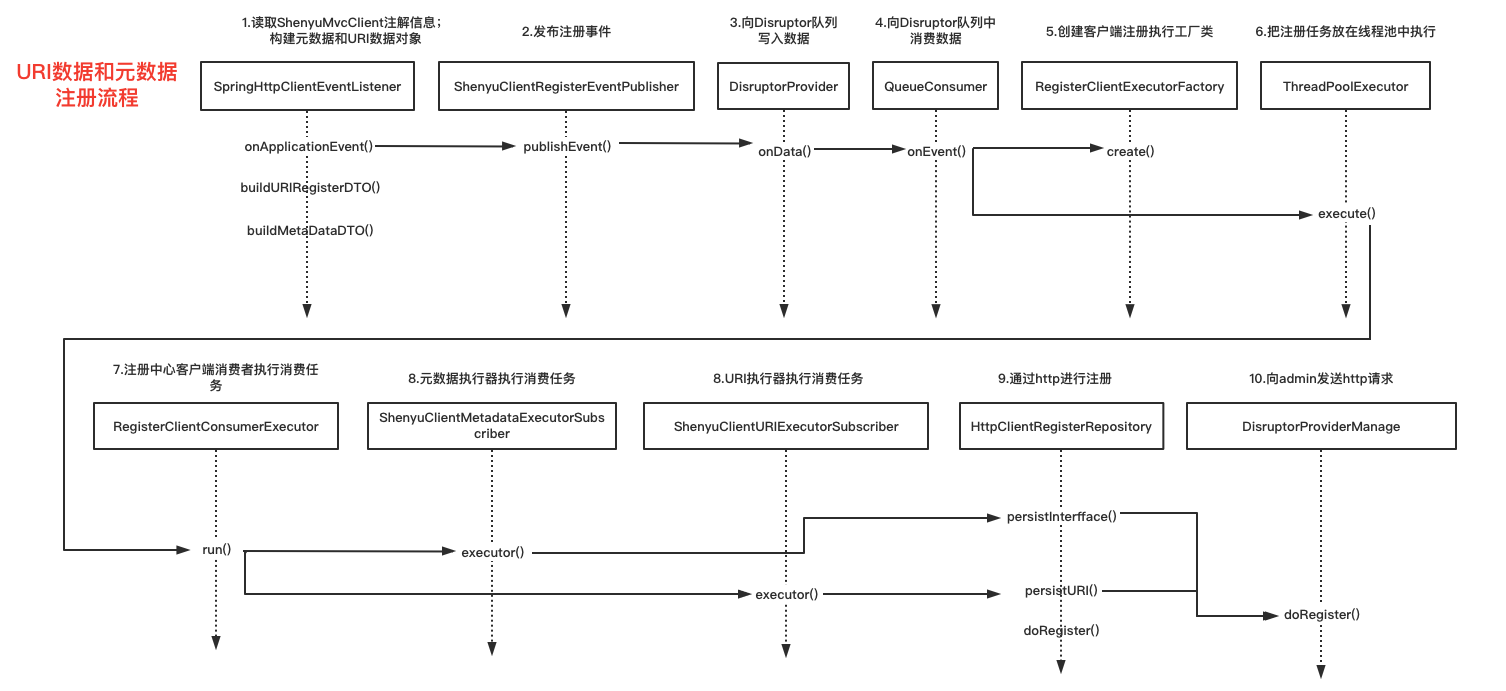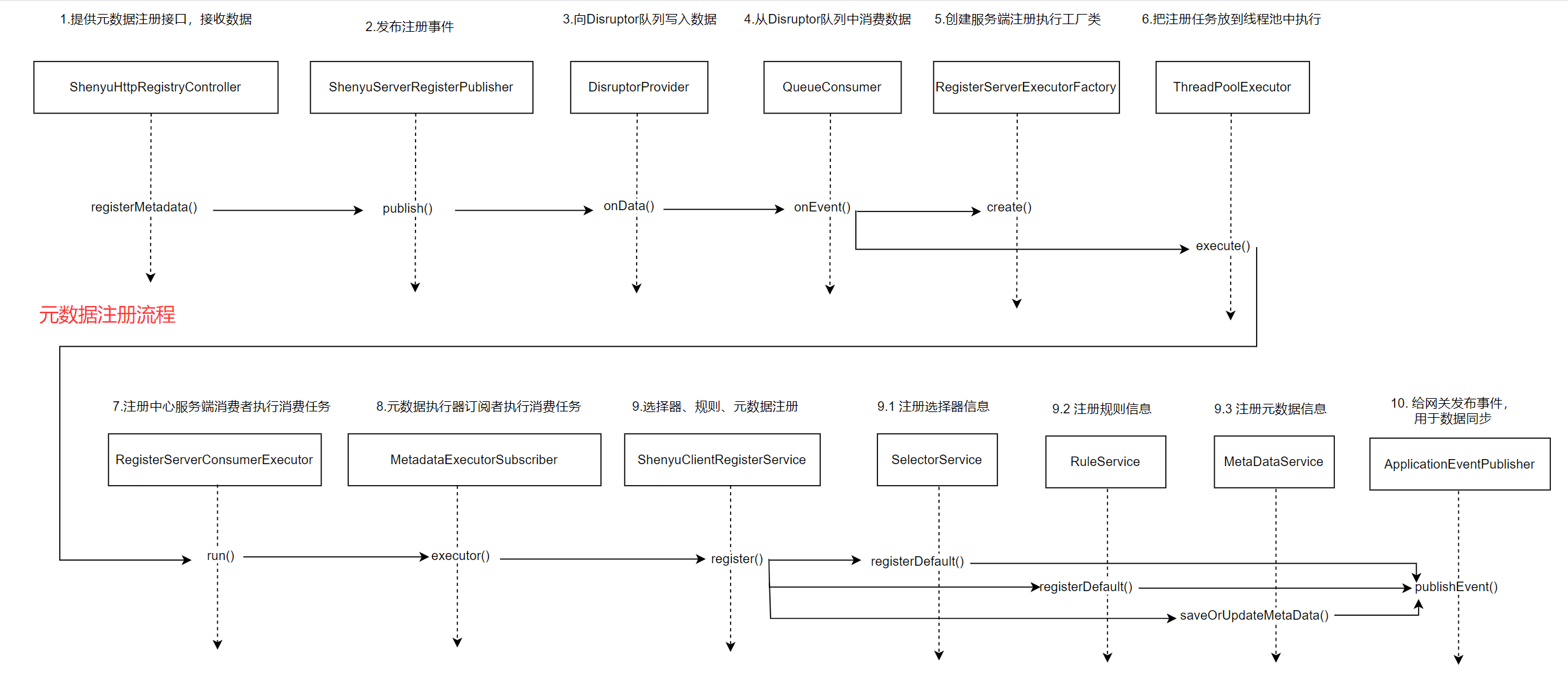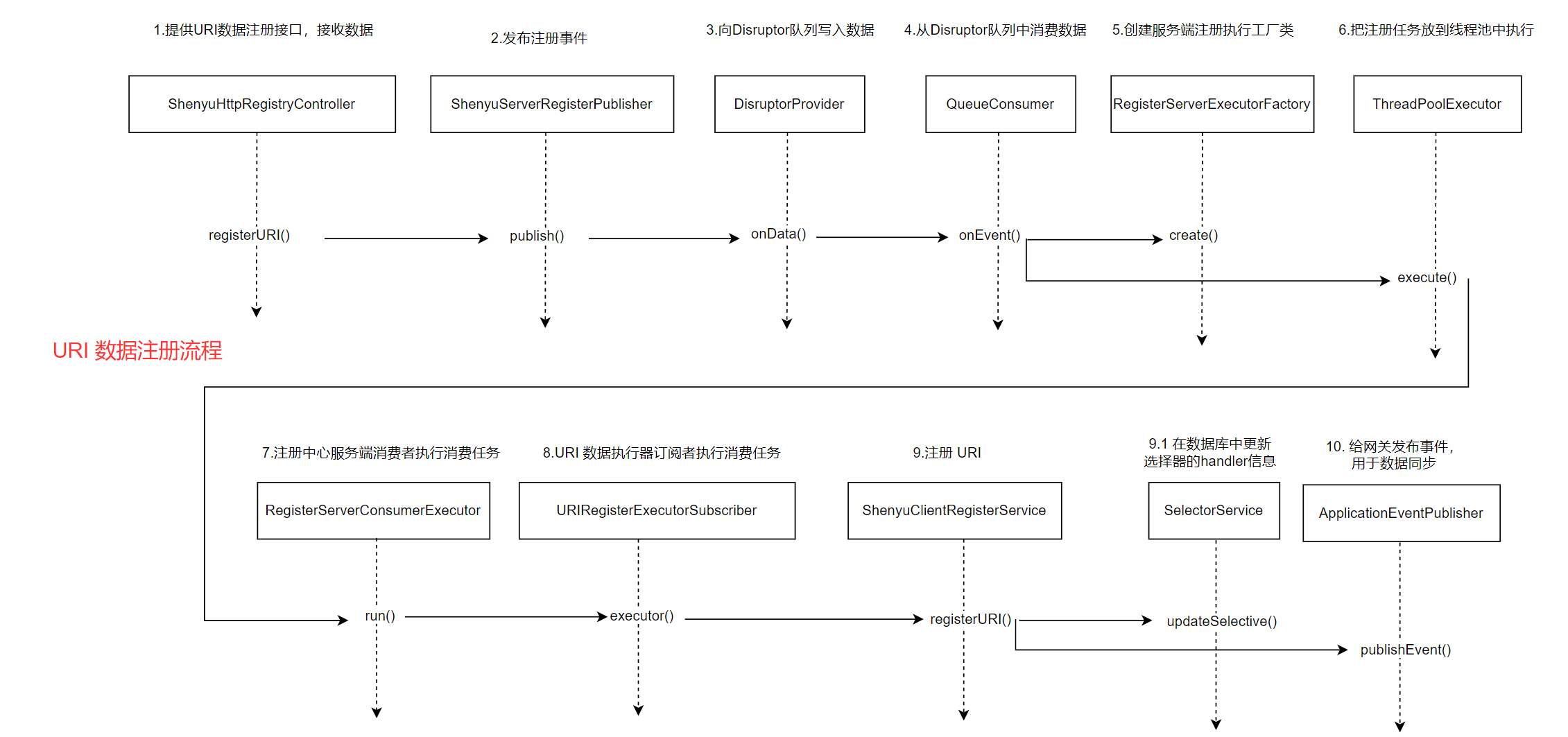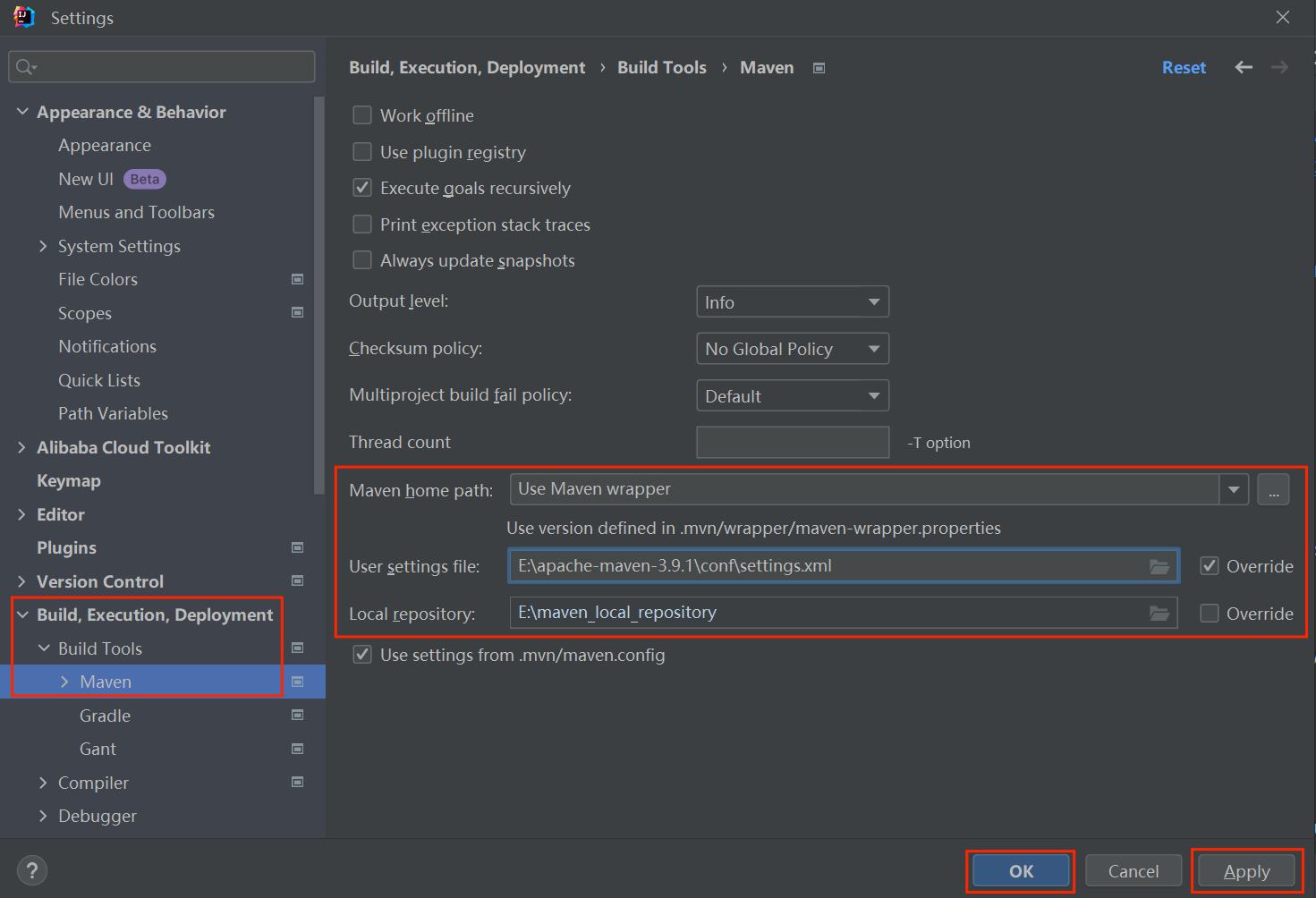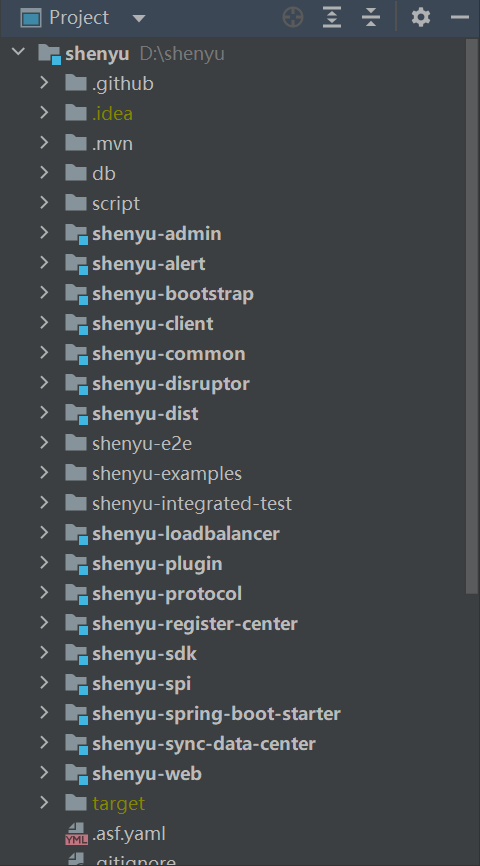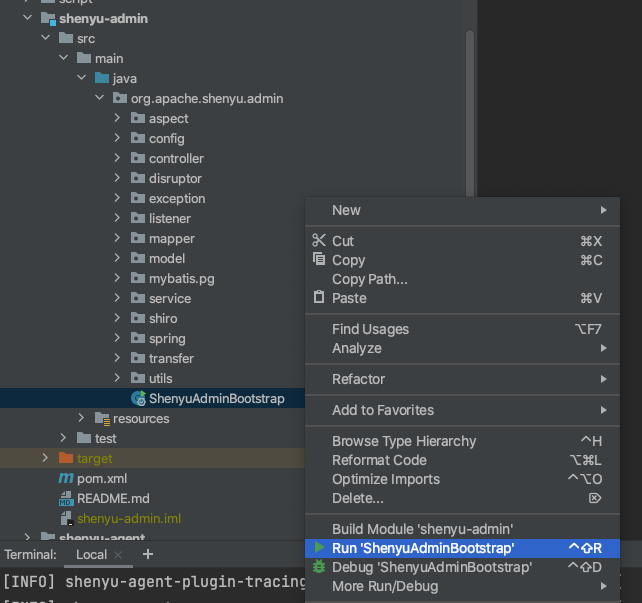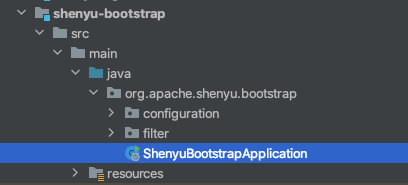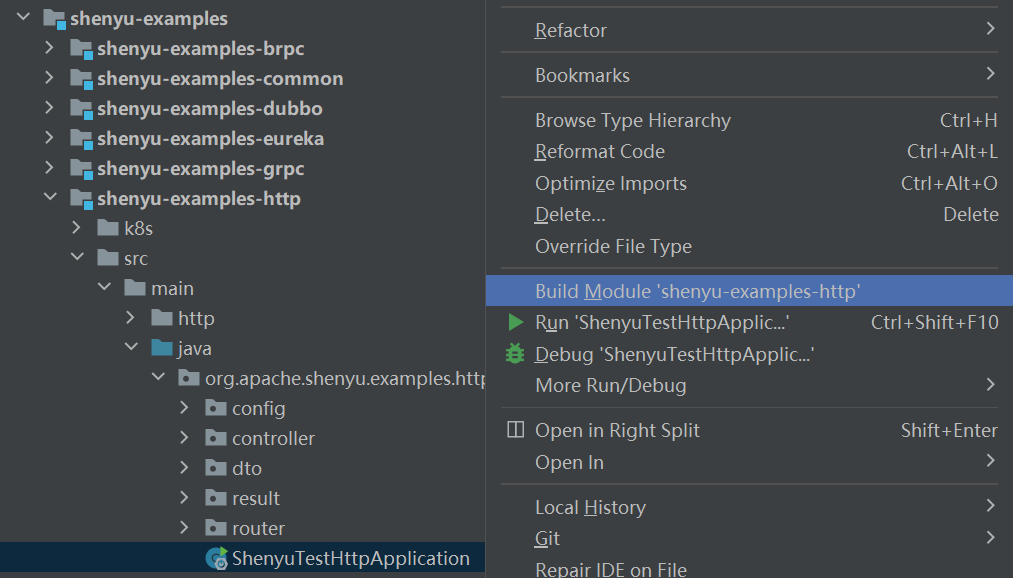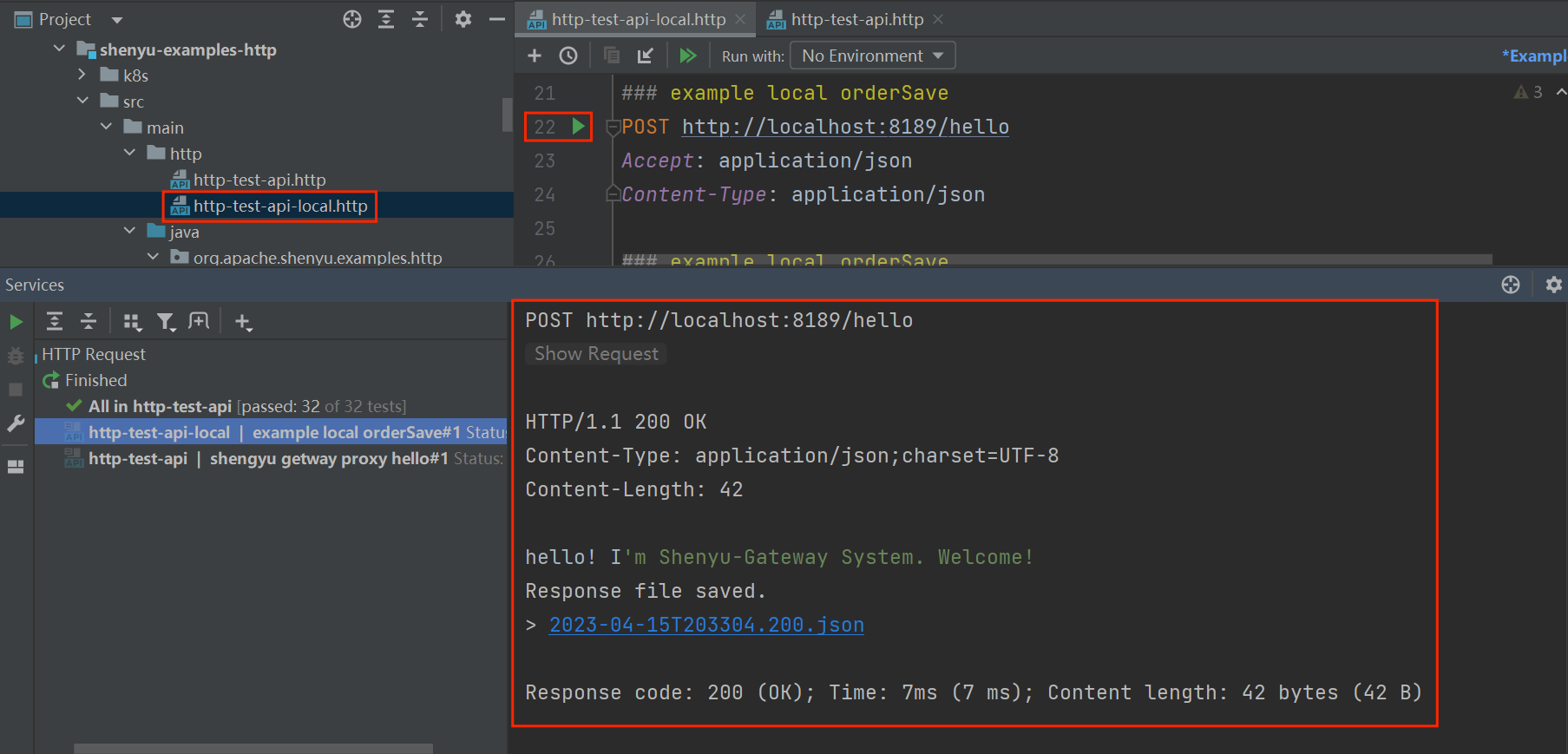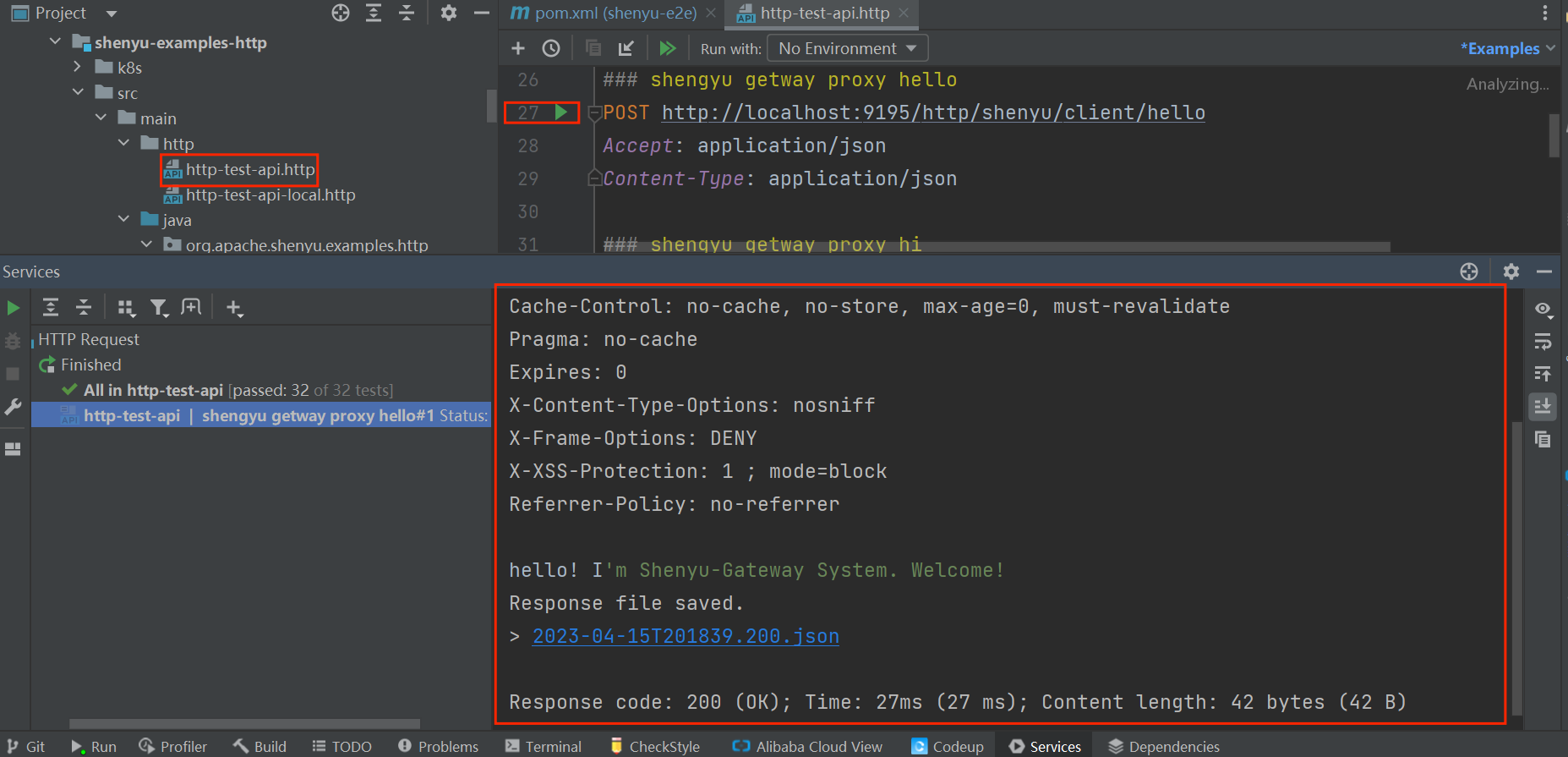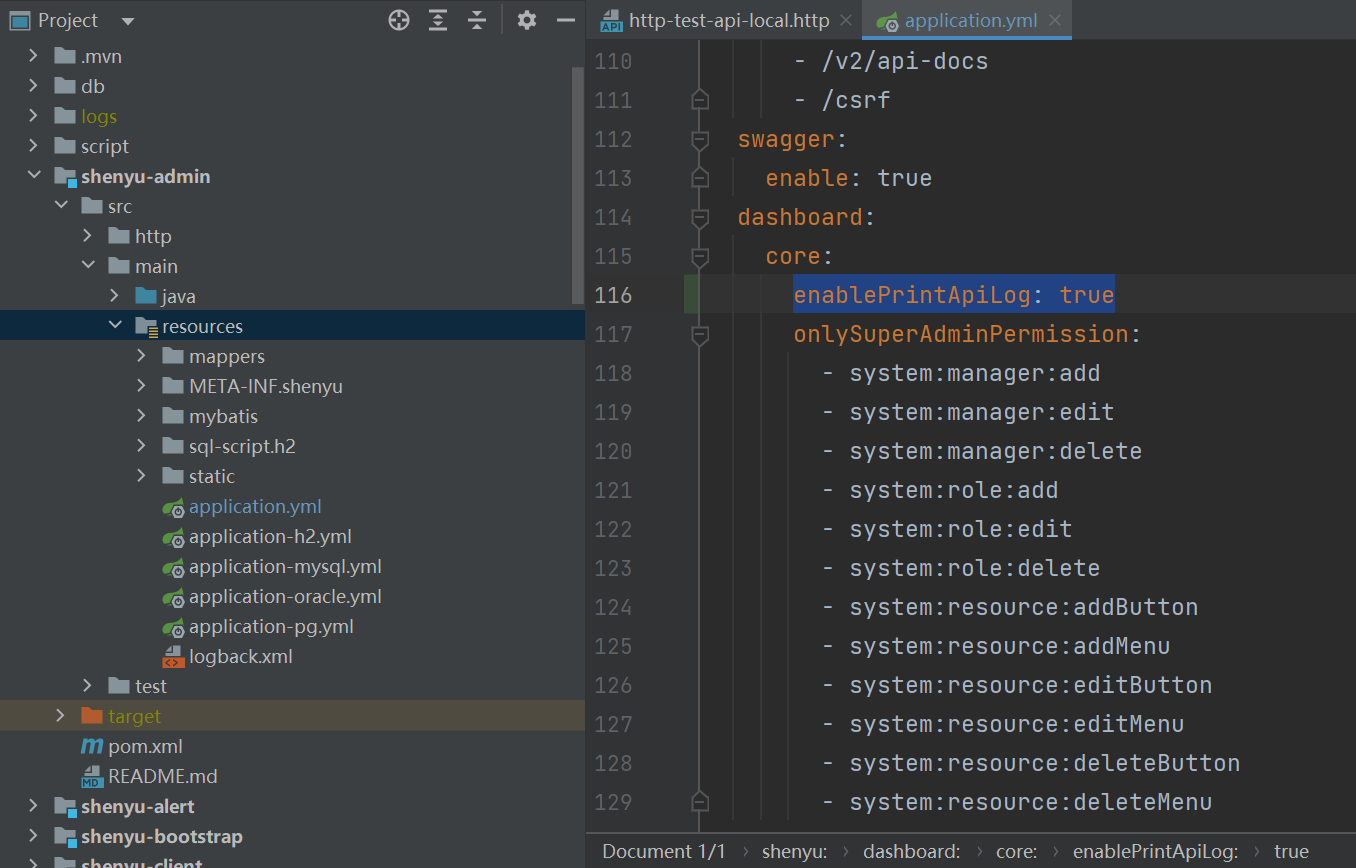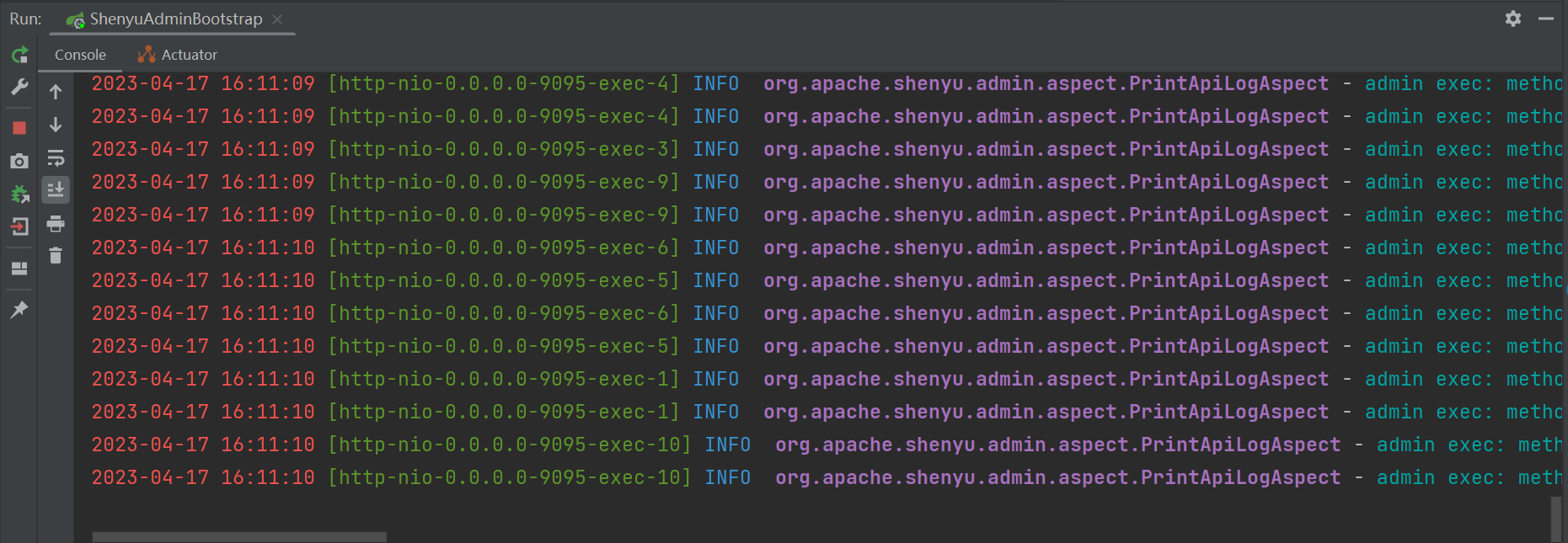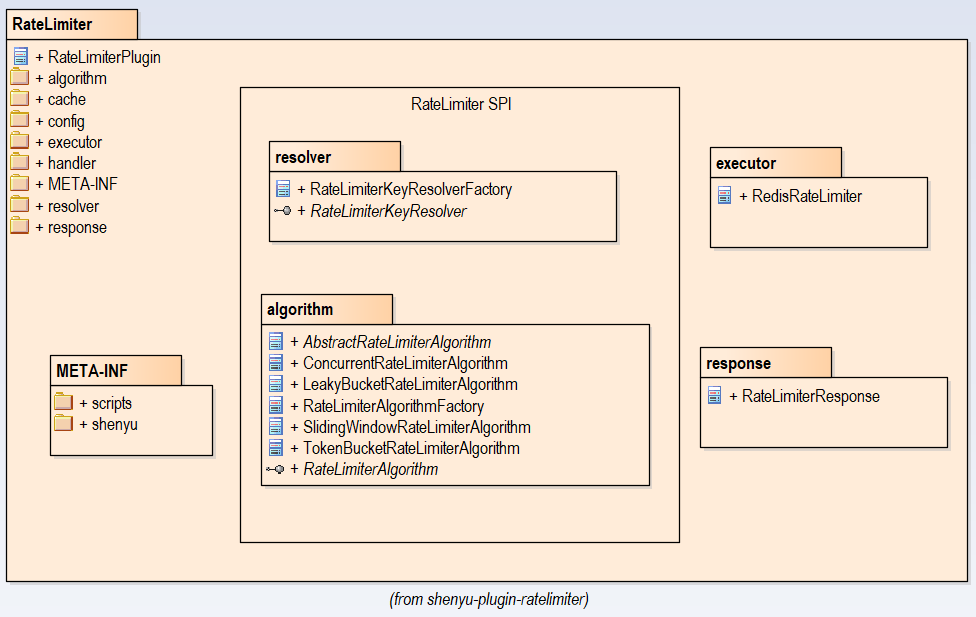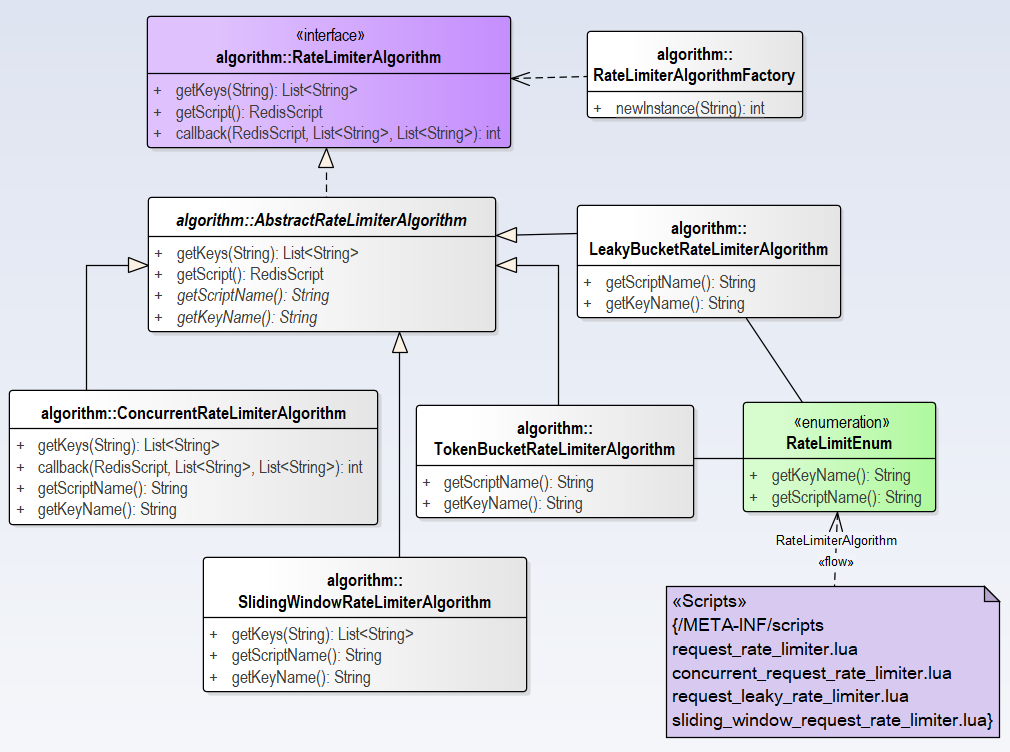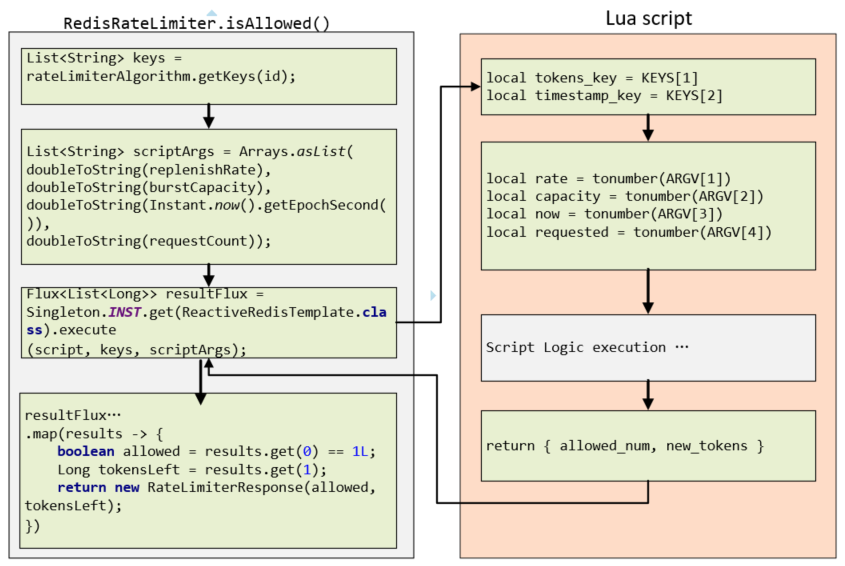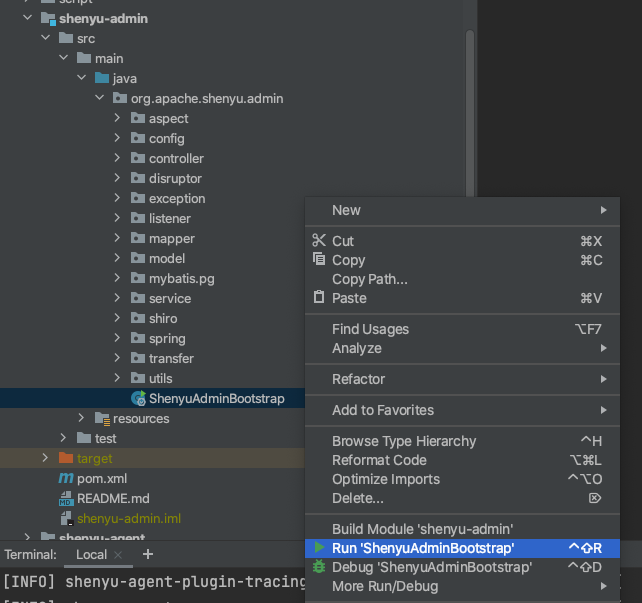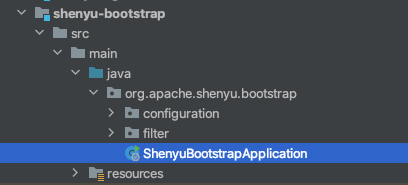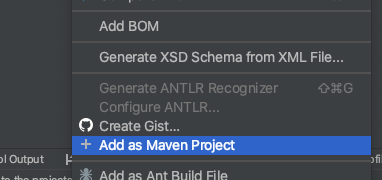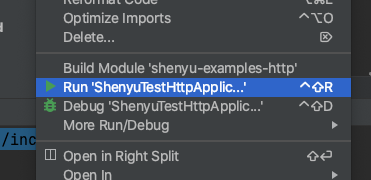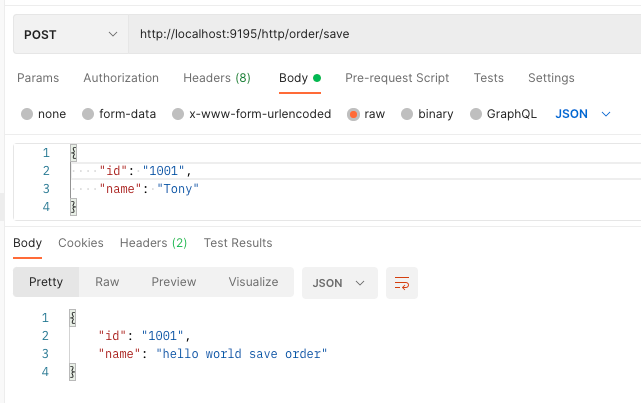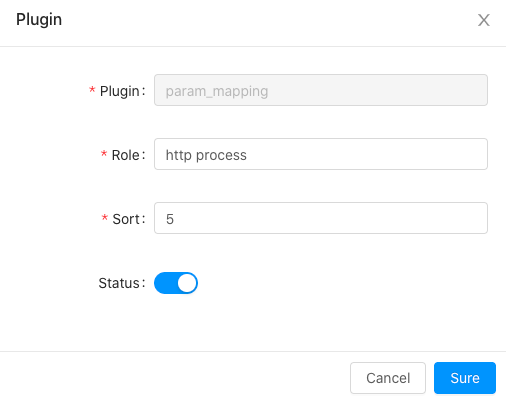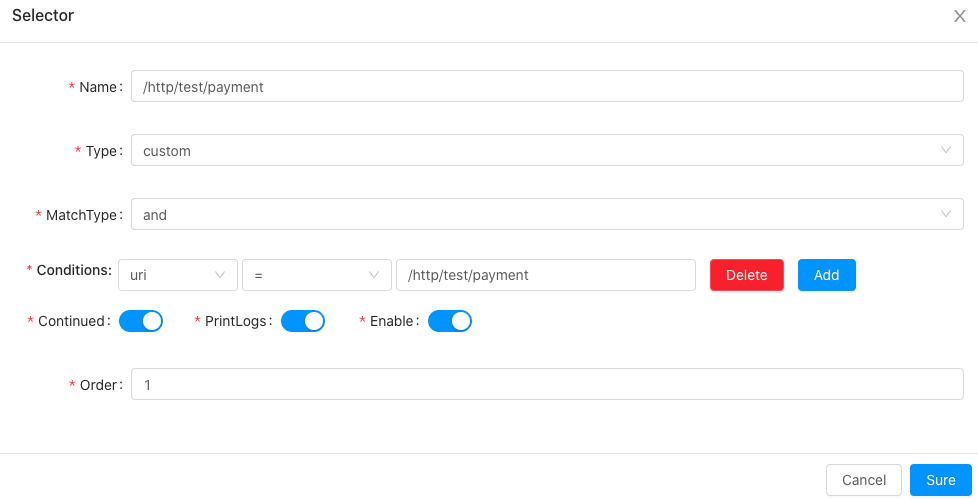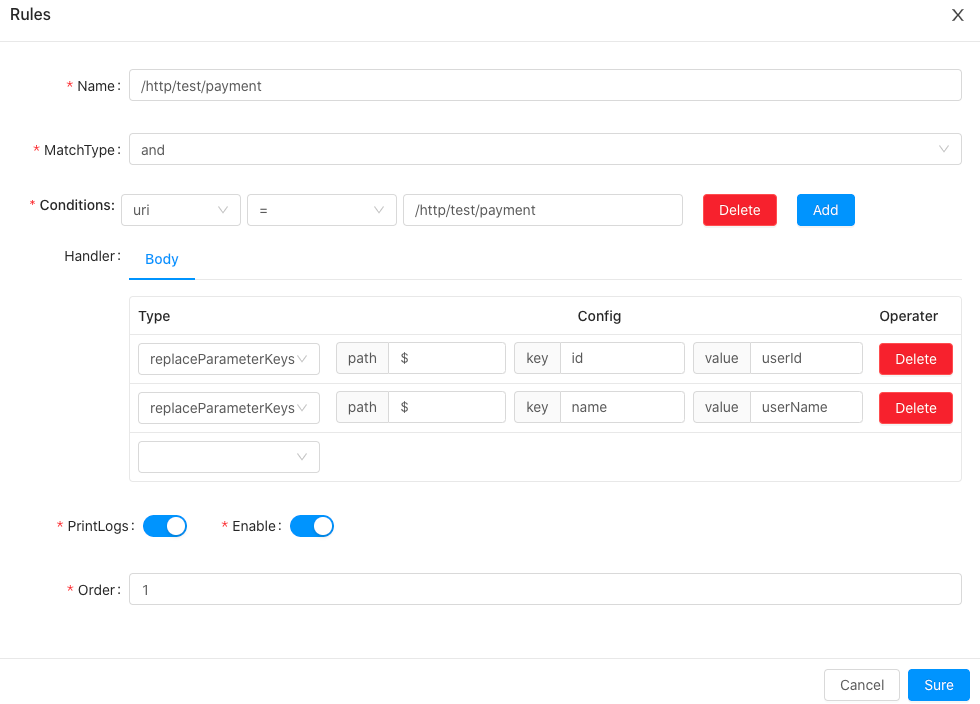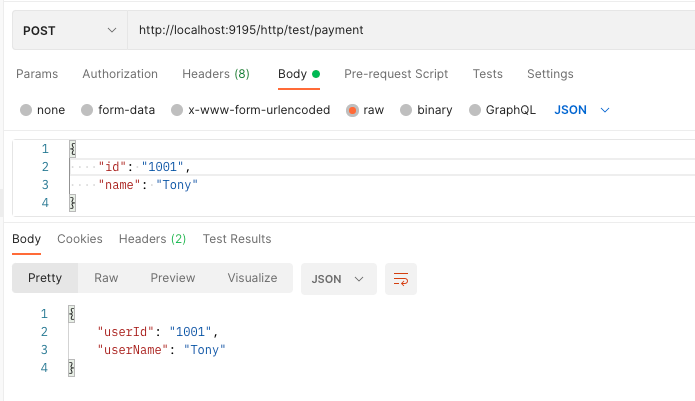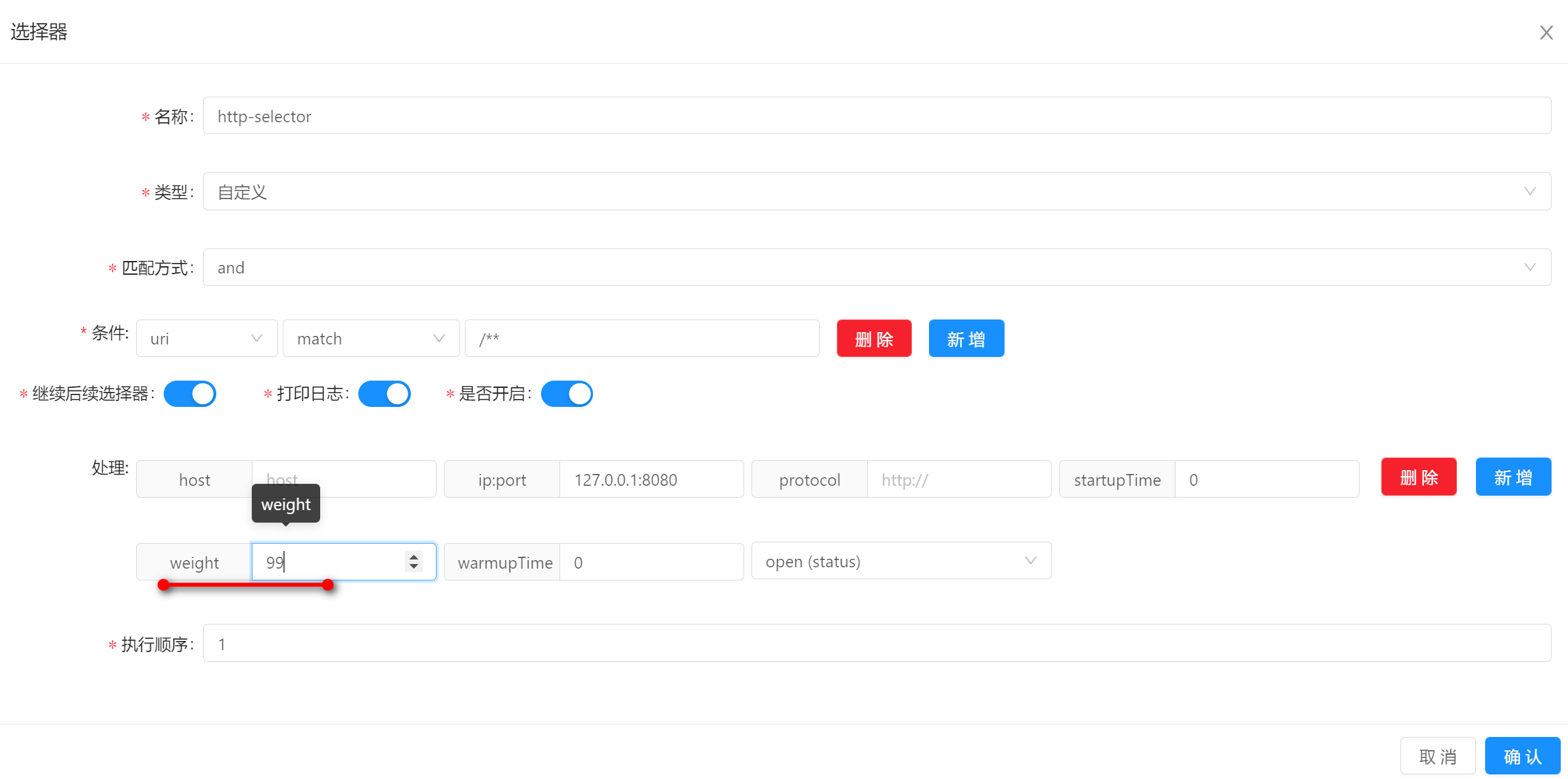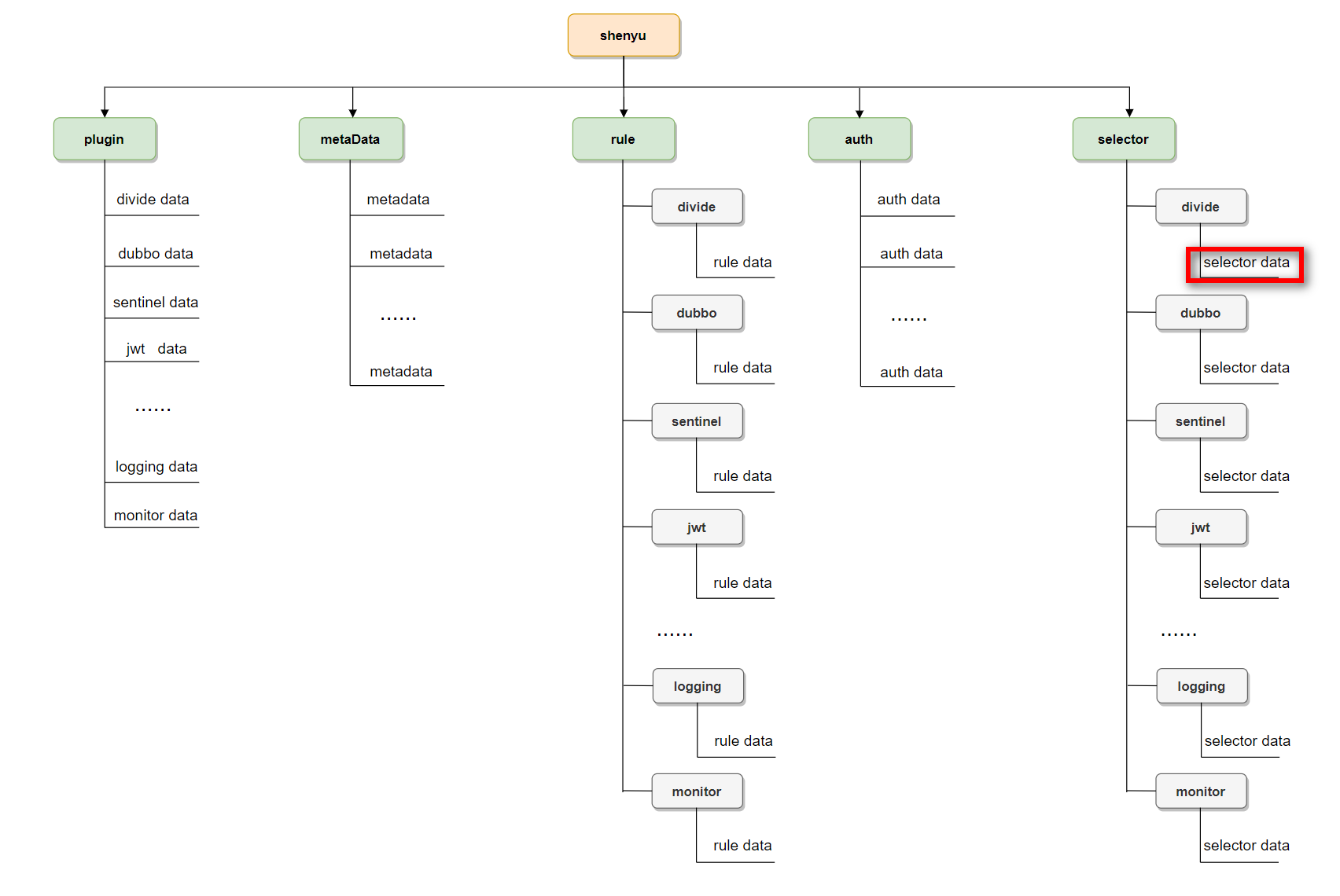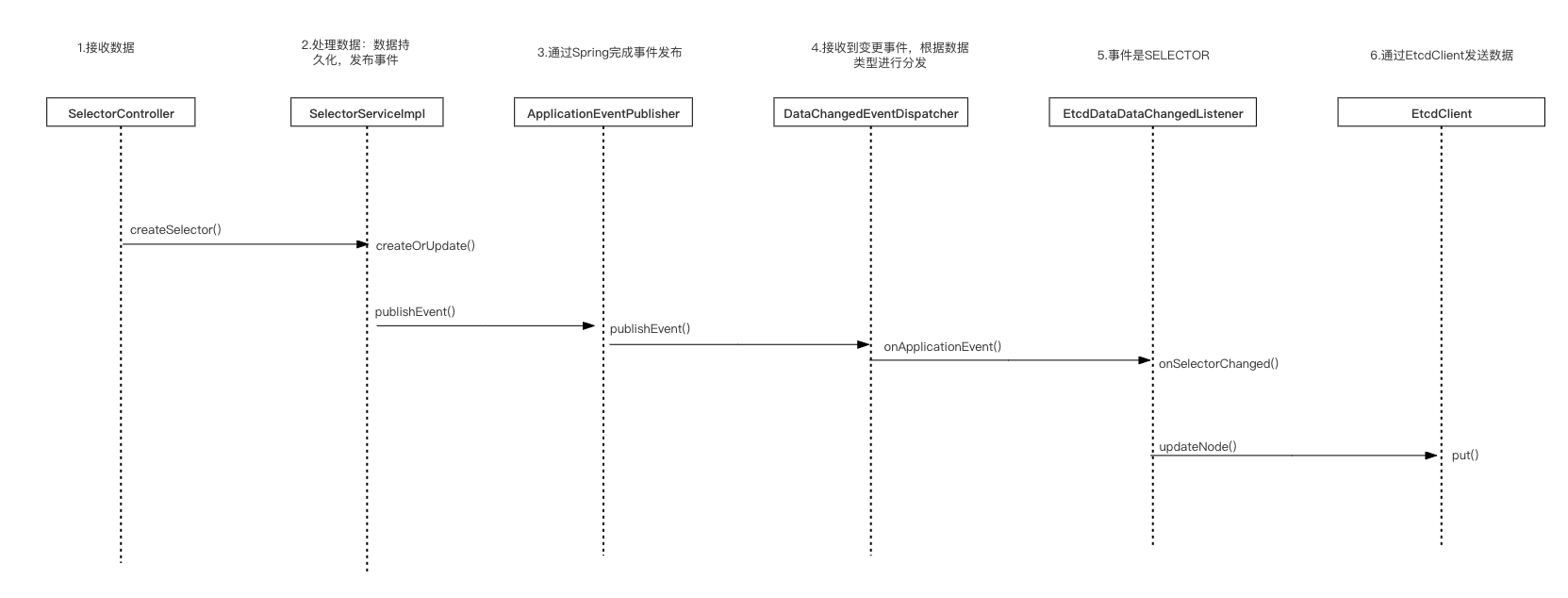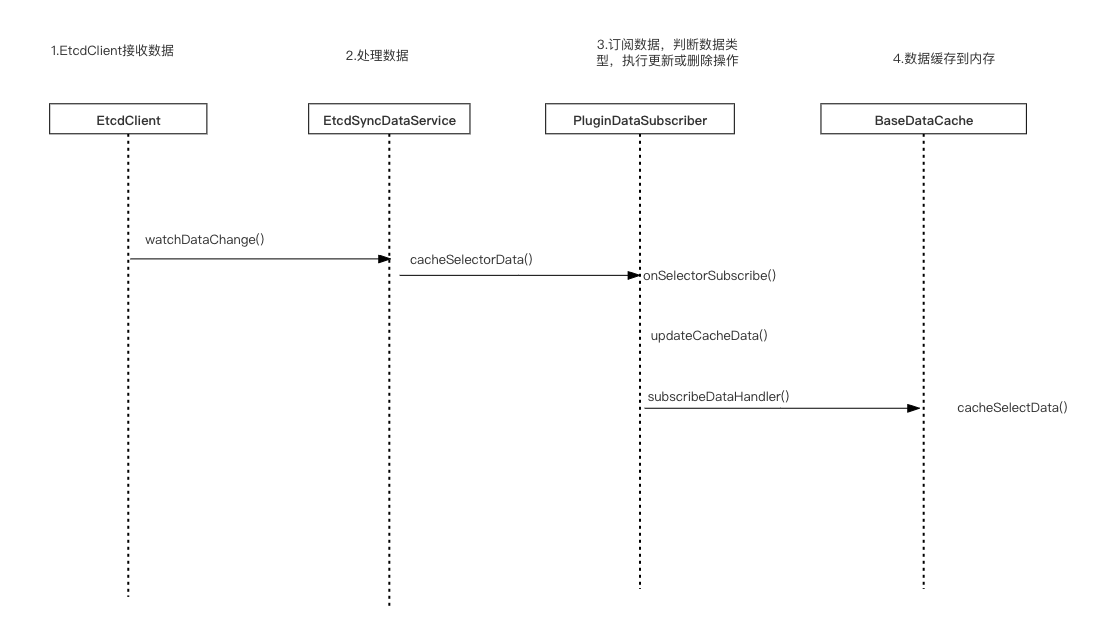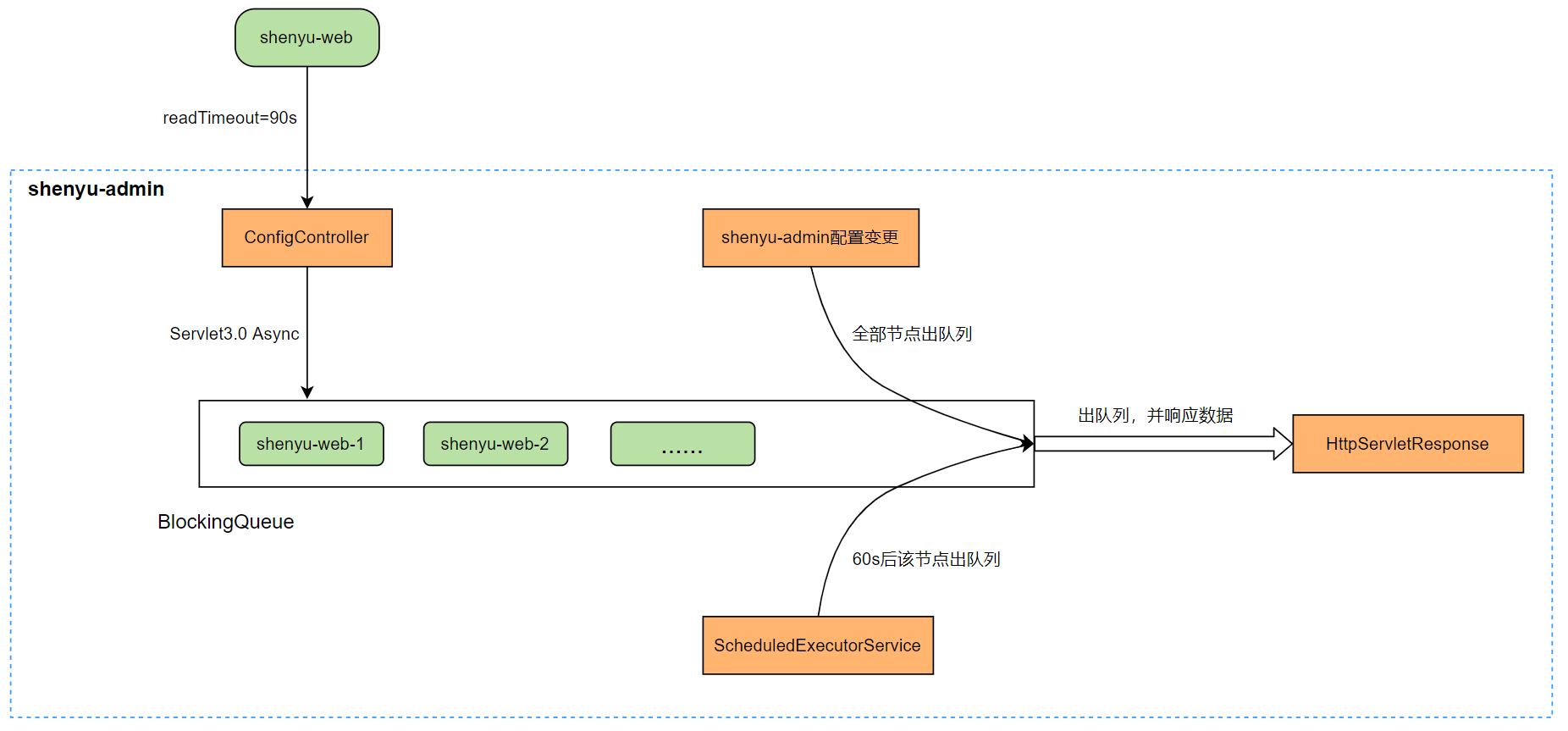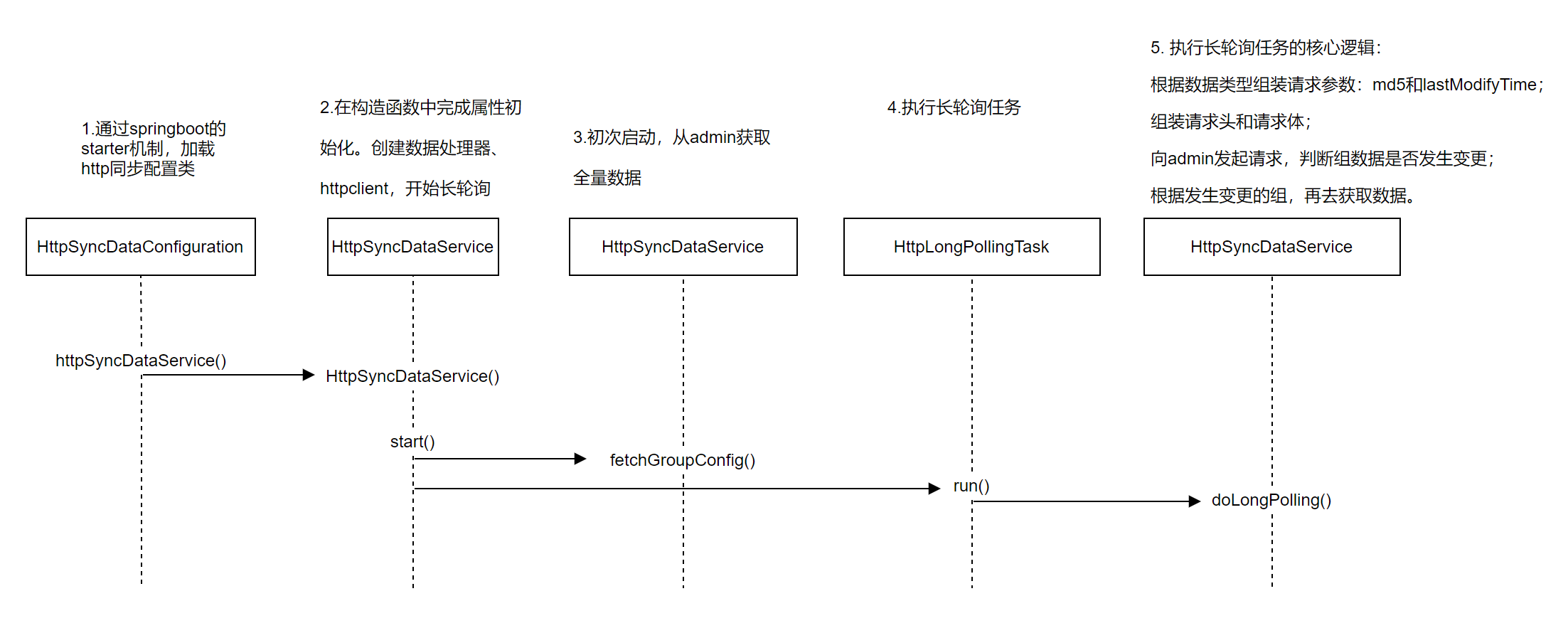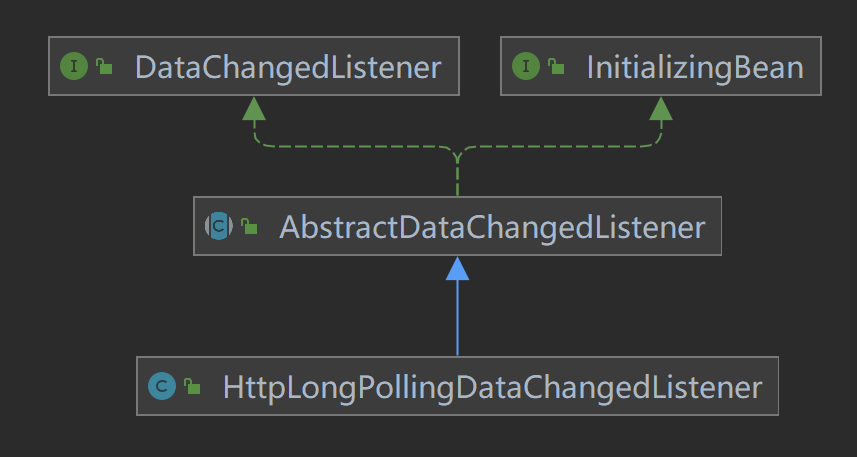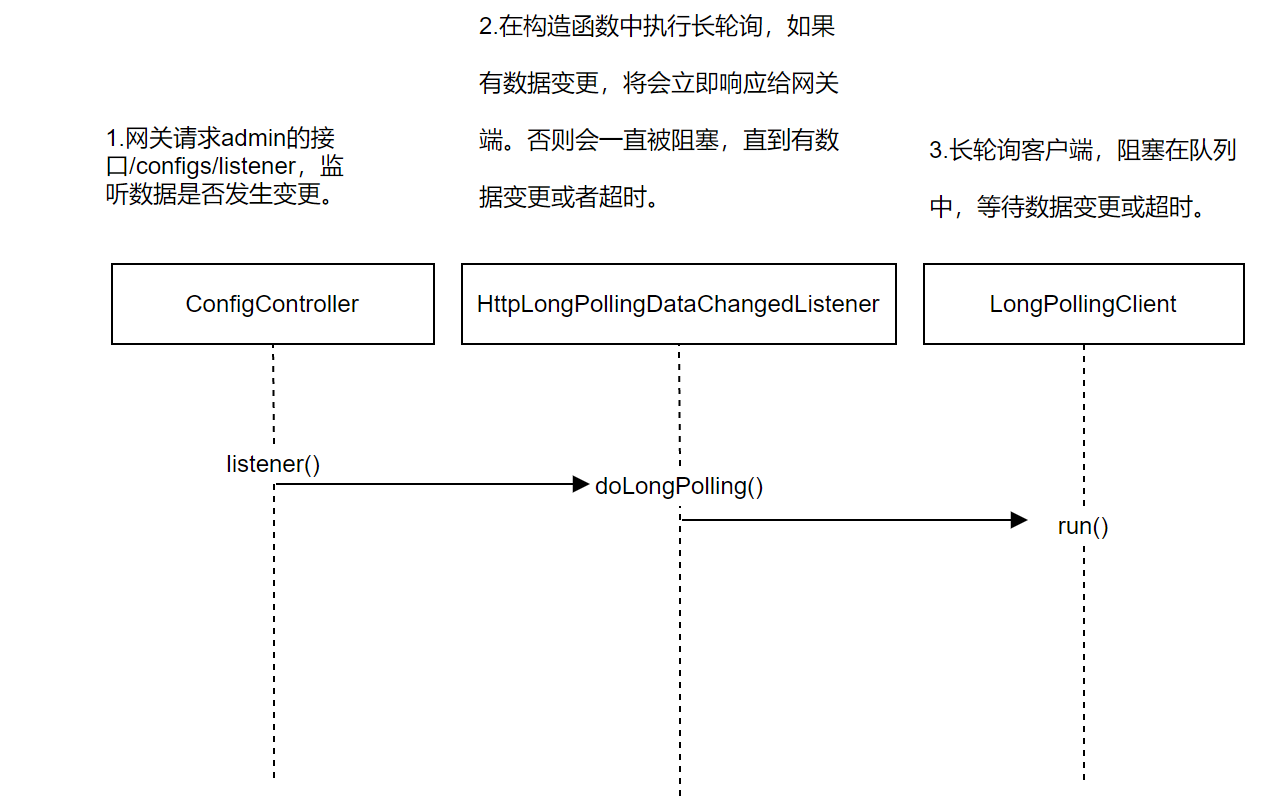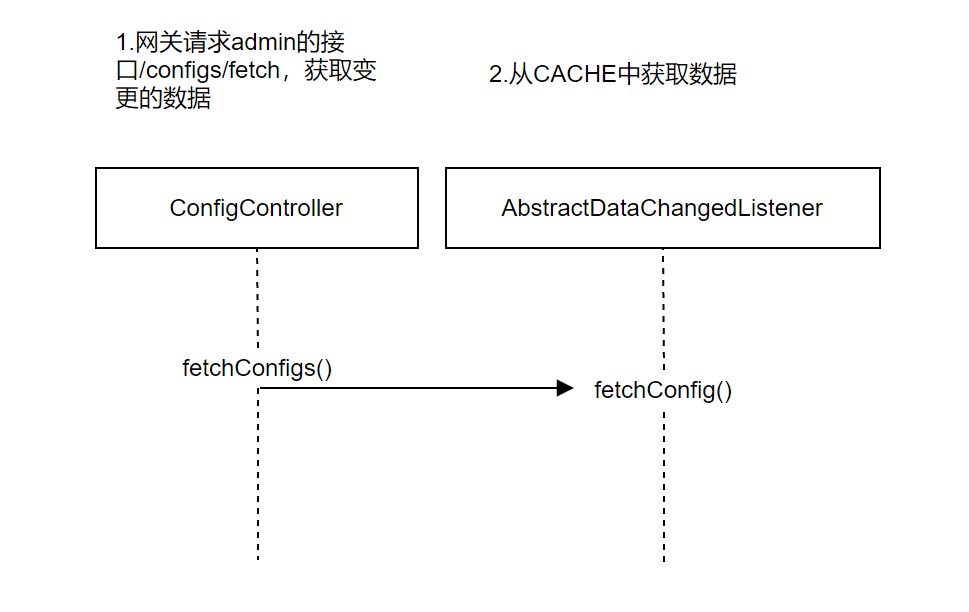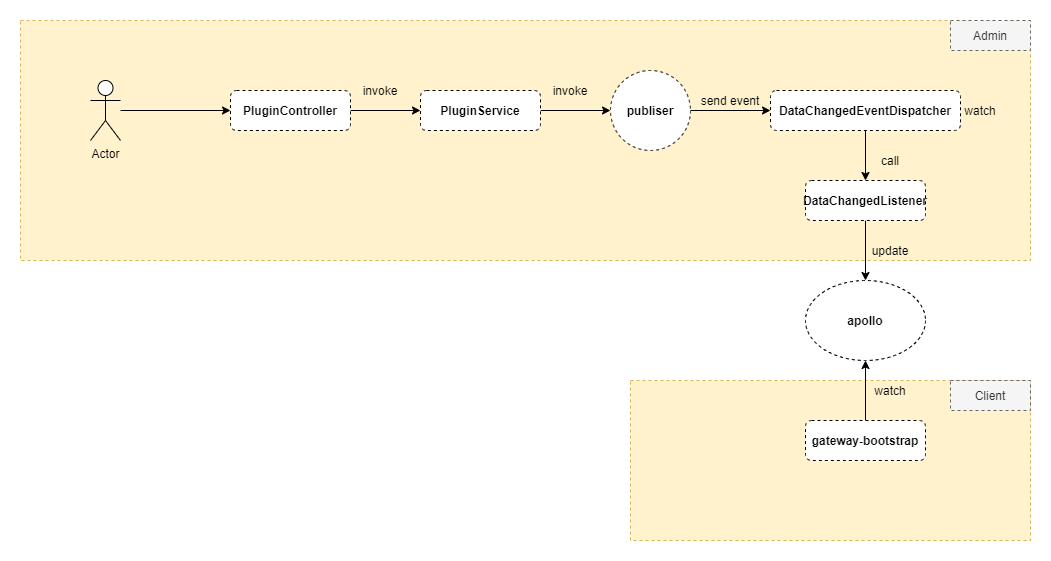Apache ShenYu 是一个异步的,高性能的,跨语言的,响应式的 API 网关。
在ShenYu网关中,注册中心是用于将客户端信息注册到shenyu-admin,admin再通过数据同步将这些信息同步到网关,网关通过这些数据完成流量筛选。客户端信息主要包括接口信息和URI信息。
本文基于shenyu-2.5.0版本进行源码分析,官网的介绍请参考 客户端接入原理 。
# 当客户端启动时,读取接口信息和uri信息,通过指定的注册类型,将数据发送到shenyu-admin。
图中的注册中心需要用户指定使用哪种注册类型,ShenYu当前支持Http、Zookeeper、Etcd、Consul和Nacos进行注册。具体如何配置请参考 客户端接入配置 。
ShenYu在注册中心的原理设计上引入了Disruptor,Disruptor队列在其中起到数据与操作解耦,利于扩展。如果注册请求过多,导致注册异常,也有数据缓冲作用。
如图所示,注册中心分为两个部分,一是注册中心客户端register-client,负责处理客户端数据读取。另一个是注册中心服务端register-server,负责处理服务端(就是shenyu-admin)数据写入。通过指定注册类型进行数据发送和接收。
客户端:通常来说就是一个微服务,可以是springmvc,spring-cloud,dubbo,grpc等。 register-client:注册中心客户端,读取客户接口和uri信息。Disruptor:数据与操作解耦,数据缓冲作用。register-server:注册中心服务端,这里就是shenyu-admin,接收数据,写入数据库,发数据同步事件。注册类型:指定注册类型,完成数据注册,当前支持Http、Zookeeper、Etcd、Consul和Nacos。 本文分析的是使用Http的方式进行注册,所以具体的处理流程如下:
在客户端,数据出队列后,通过http传输数据,在服务端,提供相应的接口,接收数据,然后写入队列。
# 当客户端启动后,根据相关配置,读取属性信息,然后写入队列。以官方提供的 shenyu-examples-http 为例,开始源码分析。官方提供的例子是一个由springboot构建的微服务。注册中心的相关配置可以参考官网 客户端接入配置 。
# 先用一张图串联下注册中心客户端初始化流程:
我们分析的是通过http的方式进行注册,所以需要进行如下配置:
shenyu : register : registerType : http serverLists : http : //localhost : 9095 props : username : admin password : 123456 client : http : props : contextPath : /http appName : http port : 8189 isFull : false Copy 每个属性表示的含义如下:
registerType: 服务注册类型,填写 http。serverList: 为http注册类型时,填写Shenyu-Admin项目的地址,注意加上http://,多个地址用英文逗号分隔。username: Shenyu-Admin用户名password: Shenyu-Admin用户对应的密码port: 你本项目的启动端口,目前springmvc/tars/grpc需要进行填写。contextPath: 为你的这个mvc项目在shenyu网关的路由前缀, 比如/order ,/product 等等,网关会根据你的这个前缀来进行路由。appName:你的应用名称,不配置的话,会默认取 spring.application.name 的值。isFull: 设置 true 代表代理你的整个服务,false表示代理你其中某几个controller;目前适用于springmvc/springcloud。项目启动后,会先加载配置文件,读取属性信息,生成相应的Bean。
首先读取到的配置文件是 ShenyuSpringMvcClientConfiguration,它是shenyu 客户端http注册配置类,通过@Configuration表示这是一个配置类,通过@ImportAutoConfiguration引入其他配置类。创建SpringMvcClientEventListener,主要处理元数据和 URI 信息。
/** * shenyu 客户端http注册配置类 */ @Configuration @ImportAutoConfiguration(ShenyuClientCommonBeanConfiguration.class) @ConditionalOnProperty(value = "shenyu.register.enabled", matchIfMissing = true, havingValue = "true") public class ShenyuSpringMvcClientConfiguration { // 创建SpringMvcClientEventListener,主要处理元数据和URI信息 @Bean public SpringMvcClientEventListener springHttpClientEventListener(final ShenyuClientConfig clientConfig, final ShenyuClientRegisterRepository shenyuClientRegisterRepository) { return new SpringMvcClientEventListener(clientConfig.getClient().get(RpcTypeEnum.HTTP.getName()), shenyuClientRegisterRepository); } }
Copy ShenyuClientCommonBeanConfiguration是shenyu客户端通用配置类,会创建注册中心客户端通用的bean。
创建ShenyuClientRegisterRepository,通过工厂类创建而成。 创建ShenyuRegisterCenterConfig,读取shenyu.register属性配置。 创建ShenyuClientConfig,读取shenyu.client属性配置。
/** * shenyu客户端通用配置类 */ @Configuration public class ShenyuClientCommonBeanConfiguration { // 创建ShenyuClientRegisterRepository,通过工厂类创建而成。 @Bean public ShenyuClientRegisterRepository shenyuClientRegisterRepository(final ShenyuRegisterCenterConfig config) { return ShenyuClientRegisterRepositoryFactory.newInstance(config); } // 创建ShenyuRegisterCenterConfig,读取shenyu.register属性配置 @Bean @ConfigurationProperties(prefix = "shenyu.register") public ShenyuRegisterCenterConfig shenyuRegisterCenterConfig() { return new ShenyuRegisterCenterConfig(); } // 创建ShenyuClientConfig,读取shenyu.client属性配置 @Bean @ConfigurationProperties(prefix = "shenyu") public ShenyuClientConfig shenyuClientConfig() { return new ShenyuClientConfig(); } }
Copy # 上面的配置文件中生成的ShenyuClientRegisterRepository是客户端注册的具体实现,它是一个接口,它的实现类如下。
HttpClientRegisterRepository:通过http进行注册;ConsulClientRegisterRepository:通过Consul进行注册;EtcdClientRegisterRepository:通过Etcd进行注册;NacosClientRegisterRepository:通过nacos进行注册;ZookeeperClientRegisterRepository通过Zookeeper进行注册。具体是哪一种方式,是通过SPI进行加载实现的,实现逻辑如下:
/** * 加载 ShenyuClientRegisterRepository */ public final class ShenyuClientRegisterRepositoryFactory { private static final Map<String, ShenyuClientRegisterRepository> REPOSITORY_MAP = new ConcurrentHashMap<>(); /** * 创建 ShenyuClientRegisterRepository */ public static ShenyuClientRegisterRepository newInstance(final ShenyuRegisterCenterConfig shenyuRegisterCenterConfig) { if (!REPOSITORY_MAP.containsKey(shenyuRegisterCenterConfig.getRegisterType())) { // 通过SPI的方式进行加载,类型由registerType决定 ShenyuClientRegisterRepository result = ExtensionLoader.getExtensionLoader(ShenyuClientRegisterRepository.class).getJoin(shenyuRegisterCenterConfig.getRegisterType()); //执行初始化操作 result.init(shenyuRegisterCenterConfig); ShenyuClientShutdownHook.set(result, shenyuRegisterCenterConfig.getProps()); REPOSITORY_MAP.put(shenyuRegisterCenterConfig.getRegisterType(), result); return result; } return REPOSITORY_MAP.get(shenyuRegisterCenterConfig.getRegisterType()); } } Copy 加载类型通过registerType指定,也就是我们在配置文件中指定的类型:
shenyu : register : registerType : http serverLists : http : //localhost : 9095 Copy 我们指定的是http,所以会去加载HttpClientRegisterRepository。对象创建成功后,执行的初始化方法init()如下:
@Join public class HttpClientRegisterRepository implements ShenyuClientRegisterRepository { @Override public void init(final ShenyuRegisterCenterConfig config) { this.username = config.getProps().getProperty(Constants.USER_NAME); this.password = config.getProps().getProperty(Constants.PASS_WORD); this.serverList = Lists.newArrayList(Splitter.on(",").split(config.getServerLists())); this.setAccessToken(); } // 暂时省略其他逻辑 } Copy 读取配置文件中的username、password和serverLists,即sheenyu-admin的访问账号、密码和地址信息,为后续数据发送做准备。类注解@Join用于SPI的加载。
SPI 全称为 Service Provider Interface, 是 JDK 内置的一种服务提供发现功能, 一种动态替换发现的机制。
shenyu-spi 是Apache ShenYu网关自定义的SPI扩展实现,设计和实现原理参考了Dubbo的 SPI扩展实现 。
# 创建 SpringMvcClientEventListener,负责客户端 元数据 和 URI 数据的构建和注册,它的创建是在配置文件中完成。
@Configuration @ImportAutoConfiguration(ShenyuClientCommonBeanConfiguration.class) @ConditionalOnProperty(value = "shenyu.register.enabled", matchIfMissing = true, havingValue = "true") public class ShenyuSpringMvcClientConfiguration { // ...... // 创建 SpringMvcClientEventListener @Bean public SpringMvcClientEventListener springHttpClientEventListener(final ShenyuClientConfig clientConfig, final ShenyuClientRegisterRepository shenyuClientRegisterRepository) { return new SpringMvcClientEventListener(clientConfig.getClient().get(RpcTypeEnum.HTTP.getName()), shenyuClientRegisterRepository); } } Copy SpringMvcClientEventListener继承了AbstractContextRefreshedEventListener
AbstractContextRefreshedEventListener是一个抽象类,它实现了ApplicationListener接口,并重写了onApplicationEvent()方法,当有Spring事件发生后,该方法会执行。它的实现目前有八种,每一种表示对应的RPC调用协议的 元数据 和URI 信息的注册。
AlibabaDubboServiceBeanListener:处理使用Alibaba Dubbo协议;ApacheDubboServiceBeanListener:处理使用Apacge Dubbo协议;GrpcClientEventListener:处理使用grpc协议;MotanServiceEventListener:处理使用Mortan协议;SofaServiceEventListener:处理使用Sofa协议;SpringMvcClientEventListener:处理使用http协议;SpringWebSocketClientEventListener:处理使用websocket协议;TarsServiceBeanEventListener:处理使用Tars注册类型;// 实现了ApplicationListener接口 public abstract class AbstractContextRefreshedEventListener<T, A extends Annotation> implements ApplicationListener<ContextRefreshedEvent> {
//......
//构造函数 public AbstractContextRefreshedEventListener(final PropertiesConfig clientConfig, final ShenyuClientRegisterRepository shenyuClientRegisterRepository) { // 读取 shenyu.client.http 配置信息 Properties props = clientConfig.getProps(); // appName 应用名称 this.appName = props.getProperty(ShenyuClientConstants.APP_NAME); // contextPath上下文路径 this.contextPath = Optional.ofNullable(props.getProperty(ShenyuClientConstants.CONTEXT_PATH)).map(UriUtils::repairData).orElse(""); if (StringUtils.isBlank(appName) && StringUtils.isBlank(contextPath)) { String errorMsg = "client register param must config the appName or contextPath"; LOG.error(errorMsg); throw new ShenyuClientIllegalArgumentException(errorMsg); } this.ipAndPort = props.getProperty(ShenyuClientConstants.IP_PORT); // host信息 this.host = props.getProperty(ShenyuClientConstants.HOST); // port 客户端端口信息 this.port = props.getProperty(ShenyuClientConstants.PORT); // 开始事件发布 publisher.start(shenyuClientRegisterRepository); }
// 当有上下文刷新事件ContextRefreshedEvent发生时,该方法会执行 @Override public void onApplicationEvent(@NonNull final ContextRefreshedEvent event) { //保证该方法的内容只执行一次 if (!registered.compareAndSet(false, true)) { return; } final ApplicationContext context = event.getApplicationContext(); // 获取声明RPC调用的类 Map<String, T> beans = getBeans(context); if (MapUtils.isEmpty(beans)) { return; } // 构建URI数据并注册 publisher.publishEvent(buildURIRegisterDTO(context, beans)); // 构建元数据并注册 beans.forEach(this::handle); }
// 交给不同的子类实现 @SuppressWarnings("all") protected abstract URIRegisterDTO buildURIRegisterDTO(ApplicationContext context, Map<String, T> beans); protected void handle(final String beanName, final T bean) { Class<?> clazz = getCorrectedClass(bean); // 获取当前bean的对应shenyu客户端的注解(对应不同的RPC调用注解不一样,像http的就是@ShenyuSpringMvcClient,而像SpringCloud的则是@ShenyuSpringCloudClient) final A beanShenyuClient = AnnotatedElementUtils.findMergedAnnotation(clazz, getAnnotationType()); // 根据bean获取对应的path(不同子类实现不一样) final String superPath = buildApiSuperPath(clazz, beanShenyuClient); // 如果包含Shenyu客户端注解或者path中包括'*',表示注册整个类的接口 if (Objects.nonNull(beanShenyuClient) && superPath.contains("*")) { // 构建类的元数据,发送注册事件 handleClass(clazz, bean, beanShenyuClient, superPath); return; } // 获取当前bean的所有方法 final Method[] methods = ReflectionUtils.getUniqueDeclaredMethods(clazz); // 遍历方法 for (Method method : methods) { // 注册符合条件的方法 handleMethod(bean, clazz, beanShenyuClient, method, superPath); } }
// 构建类元数据并注册的默认实现 protected void handleClass(final Class<?> clazz, final T bean, @NonNull final A beanShenyuClient, final String superPath) { publisher.publishEvent(buildMetaDataDTO(bean, beanShenyuClient, pathJoin(contextPath, superPath), clazz, null)); }
// 构建方法元数据并注册的默认实现 protected void handleMethod(final T bean, final Class<?> clazz, @Nullable final A beanShenyuClient, final Method method, final String superPath) { // 如果方法上有Shenyu客户端注解,就表示该方法需要注册 A methodShenyuClient = AnnotatedElementUtils.findMergedAnnotation(method, getAnnotationType()); if (Objects.nonNull(methodShenyuClient)) { // 构建元数据,发送注册事件 publisher.publishEvent(buildMetaDataDTO(bean, methodShenyuClient, buildApiPath(method, superPath, methodShenyuClient), clazz, method)); } }
// 交给不同子类实现 protected abstract MetaDataRegisterDTO buildMetaDataDTO(T bean, @NonNull A shenyuClient, String path, Class<?> clazz, Method method); }
Copy 在构造函数中主要是读取属性配置。
shenyu : client : http : props : contextPath : /http appName : http port : 8189 isFull : false Copy 最后,执行了publisher.start(),开始事件发布,为注册做准备。
ShenyuClientRegisterEventPublisher ShenyuClientRegisterEventPublisher通过单例模式实现,主要是生成元数据和URI订阅器(后续用于数据发布),然后启动Disruptor队列。提供了一个共有方法publishEvent(),发布事件,向Disruptor队列发数据。
public class ShenyuClientRegisterEventPublisher { // 私有变量 private static final ShenyuClientRegisterEventPublisher INSTANCE = new ShenyuClientRegisterEventPublisher();
private DisruptorProviderManage<DataTypeParent> providerManage; /** * 公开静态方法 * * @return ShenyuClientRegisterEventPublisher instance */ public static ShenyuClientRegisterEventPublisher getInstance() { return INSTANCE; } /** * Start方法执行 * * @param shenyuClientRegisterRepository shenyuClientRegisterRepository */ public void start(final ShenyuClientRegisterRepository shenyuClientRegisterRepository) { // 创建客户端注册工厂类 RegisterClientExecutorFactory factory = new RegisterClientExecutorFactory(); // 添加元数据订阅器 factory.addSubscribers(new ShenyuClientMetadataExecutorSubscriber(shenyuClientRegisterRepository)); // 添加URI订阅器 factory.addSubscribers(new ShenyuClientURIExecutorSubscriber(shenyuClientRegisterRepository)); // 启动Disruptor队列 providerManage = new DisruptorProviderManage(factory); providerManage.startup(); } /** * 发布事件,向Disruptor队列发数据 * * @param data the data */ public <T> void publishEvent(final DataTypeParent data) { DisruptorProvider<DataTypeParent> provider = providerManage.getProvider(); provider.onData(data); } } Copy AbstractContextRefreshedEventListener的构造函数逻辑分析完成了,主要是读取属性配置,创建元数据和URI订阅器,启动Disruptor队列。
onApplicationEvent()方法是有Spring事件发生时会执行,这里的参数是ContextRefreshedEvent,表示上下文刷新事件。当Spring容器就绪后执行此处逻辑:先构建URI数据并注册,再构建元数据并注册,
ContextRefreshedEvent是Spring内置事件。ApplicationContext被初始化或刷新时,该事件被触发。这也可以在 ConfigurableApplicationContext接口中使用 refresh() 方法来发生。此处的初始化是指:所有的Bean被成功装载,后处理Bean被检测并激活,所有Singleton Bean 被预实例化,ApplicationContext容器已就绪可用。
再来看AbstractContextRefreshedEventListener的http实现SpringMvcClientEventListener。
public class SpringMvcClientEventListener extends AbstractContextRefreshedEventListener<Object, ShenyuSpringMvcClient> { private final List<Class<? extends Annotation>> mappingAnnotation = new ArrayList<>(3); private final Boolean isFull; private final String protocol; // 构造函数 public SpringMvcClientEventListener(final PropertiesConfig clientConfig, final ShenyuClientRegisterRepository shenyuClientRegisterRepository) { super(clientConfig, shenyuClientRegisterRepository); Properties props = clientConfig.getProps(); // 获取 isFull this.isFull = Boolean.parseBoolean(props.getProperty(ShenyuClientConstants.IS_FULL, Boolean.FALSE.toString())); // 表示是http协议的实现 this.protocol = props.getProperty(ShenyuClientConstants.PROTOCOL, ShenyuClientConstants.HTTP); mappingAnnotation.add(ShenyuSpringMvcClient.class); mappingAnnotation.add(RequestMapping.class); } @Override protected Map<String, Object> getBeans(final ApplicationContext context) { // 配置属性,如果 isFull=true 的话,表示注册整个微服务 if (Boolean.TRUE.equals(isFull)) { getPublisher().publishEvent(MetaDataRegisterDTO.builder() .contextPath(getContextPath()) .appName(getAppName()) .path(PathUtils.decoratorPathWithSlash(getContextPath())) .rpcType(RpcTypeEnum.HTTP.getName()) .enabled(true) .ruleName(getContextPath()) .build()); return null; } // 否则获取带Controller注解的bean return context.getBeansWithAnnotation(Controller.class); } // 构造URI数据 @Override protected URIRegisterDTO buildURIRegisterDTO(final ApplicationContext context, final Map<String, Object> beans) { // ... } @Override protected String buildApiSuperPath(final Class<?> clazz, @Nullable final ShenyuSpringMvcClient beanShenyuClient) { // 如果有带上Shenyu客户端注解,则优先取注解中的不为空的path属性 if (Objects.nonNull(beanShenyuClient) && StringUtils.isNotBlank(beanShenyuClient.path())) { return beanShenyuClient.path(); } // 如果有带上RequestMapping注解,且path属性不为空,则返回path数组的第一个值 RequestMapping requestMapping = AnnotationUtils.findAnnotation(clazz, RequestMapping.class); if (Objects.nonNull(requestMapping) && ArrayUtils.isNotEmpty(requestMapping.path()) && StringUtils.isNotBlank(requestMapping.path()[0])) { return requestMapping.path()[0]; } return ""; } // 声明http实现的客户端注解是ShenyuSpringMvcClient @Override protected Class<ShenyuSpringMvcClient> getAnnotationType() { return ShenyuSpringMvcClient.class; } @Override protected void handleMethod(final Object bean, final Class<?> clazz, @Nullable final ShenyuSpringMvcClient beanShenyuClient, final Method method, final String superPath) { // 获取当前bean的RequestMapping注解 final RequestMapping requestMapping = AnnotatedElementUtils.findMergedAnnotation(method, RequestMapping.class); // 获取当前bean的 ShenyuSpringMvcClient 注解 ShenyuSpringMvcClient methodShenyuClient = AnnotatedElementUtils.findMergedAnnotation(method, ShenyuSpringMvcClient.class); methodShenyuClient = Objects.isNull(methodShenyuClient) ? beanShenyuClient : methodShenyuClient; //如果有 ShenyuSpringMvcClient 注解并且包含RequestMapping注解(表示是一个接口),则进行注册 if (Objects.nonNull(methodShenyuClient) && Objects.nonNull(requestMapping)) { getPublisher().publishEvent(buildMetaDataDTO(bean, methodShenyuClient, buildApiPath(method, superPath, methodShenyuClient), clazz, method)); } } //... // 构造元数据 @Override protected MetaDataRegisterDTO buildMetaDataDTO(final Object bean, @NonNull final ShenyuSpringMvcClient shenyuClient, final String path, final Class<?> clazz, final Method method) { //... } } Copy 注册逻辑都是通过 publisher.publishEvent()完成。
Controller注解和RequestMapping注解是由Spring提供的,这个大家应该很熟悉,不过多赘述。ShenyuSpringMvcClient 注解是由Apache ShenYu提供的,用于注册SpringMvc客户端,它的定义如下:
/** * shenyu 客户端接口,用于方法上或类上 */ @Retention(RetentionPolicy.RUNTIME) @Target({ElementType.TYPE, ElementType.METHOD}) public @interface ShenyuSpringMvcClient {
// path 注册路径 @AliasFor(attribute = "path") String value() default ""; // path 注册路径 @AliasFor(attribute = "value") String path(); // ruleName 规则名称 String ruleName() default ""; // desc 描述信息 String desc() default "";
// enabled是否启用 boolean enabled() default true; // registerMetaData 注册元数据 boolean registerMetaData() default false; }
Copy 它的使用如下:
@RestController @RequestMapping("/test") @ShenyuSpringMvcClient(path = "/test/**") // 表示整个接口注册 public class HttpTestController { //...... } Copy @RestController @RequestMapping("/order") @ShenyuSpringMvcClient(path = "/order") public class OrderController {
/** * Save order dto. * * @param orderDTO the order dto * @return the order dto */ @PostMapping("/save") @ShenyuSpringMvcClient(path = "/save", desc = "Save order") // 注册当前方法 public OrderDTO save(@RequestBody final OrderDTO orderDTO) { orderDTO.setName("hello world save order"); return orderDTO; } } Copy publisher.publishEvent() 发布注册事件 该方法会将数据发送到Disruptor队列中,关于Disruptor队列更多细节这里不做更多介绍,这不影响分析注册的流程。
当数据发送后,Disruptor队列的消费者会处理数据,进行消费。
QueueConsumer是一个消费者,它实现了WorkHandler接口,它的创建过程在providerManage.startup()逻辑中。WorkHandler接口是disruptor的数据消费接口,只有一个方法是onEvent()。
package com.lmax.disruptor;
public interface WorkHandler<T> { void onEvent(T event) throws Exception; } Copy QueueConsumer重写了onEvent()方法,主要逻辑是生成消费任务,然后在线程池中去执行。
/** * * 队列消费者 */ public class QueueConsumer<T> implements WorkHandler<DataEvent<T>> { // 省略了其他逻辑
@Override public void onEvent(final DataEvent<T> t) { if (t != null) { // 根据事件类型使用不同的线程池 ThreadPoolExecutor executor = orderly(t); // 通过工厂创建队列消费任务 QueueConsumerExecutor<T> queueConsumerExecutor = factory.create(); // 保存数据 queueConsumerExecutor.setData(t.getData()); // help gc t.setData(null); // 放在线程池中执行 消费任务 executor.execute(queueConsumerExecutor); } } } Copy QueueConsumerExecutor是在线程池中被执行的任务,它实现了Runnable接口,具体的实现类有两个:
RegisterClientConsumerExecutor:客户端消费者执行器;RegisterServerConsumerExecutor:服务端消费者执行器。顾名思义,一个负责处理客户端任务,一个负责处理服务端任务(服务端就是admin,在下文进行分析)。
RegisterClientConsumerExecutor 消费者执行器 重写的run()逻辑如下:
public final class RegisterClientConsumerExecutor<T extends DataTypeParent> extends QueueConsumerExecutor<T> { //......
@Override public void run() { // 获取数据 final T data = getData(); // 根据数据类型调用相应的处理器进行处理 subscribers.get(data.getType()).executor(Lists.newArrayList(data)); } } Copy 根据不同的数据类型调用不同的处理器去执行相应的任务。数据类型有两种,一个是元数据,记录客户端注册信息。一个是URI数据,记录客户端服务信息。
//数据类型 public enum DataType { // 元数据 META_DATA, // URI数据 URI, } Copy ExecutorSubscriber#executor() 执行器订阅者 执行器订阅者也分为两类,一个是处理元数据,一个是处理URI。在客户端和服务端分别有两个,所以一共是四个。
先看元数据处理
ShenyuClientMetadataExecutorSubscriber#executor() 客户端这边对元数据处理逻辑是:遍历元数据信息,调用接口方法persistInterface()完成数据的发布。
public class ShenyuClientMetadataExecutorSubscriber implements ExecutorTypeSubscriber<MetaDataRegisterDTO> { //...... @Override public DataType getType() { return DataType.META_DATA; // 元数据 } @Override public void executor(final Collection<MetaDataRegisterDTO> metaDataRegisterDTOList) { for (MetaDataRegisterDTO metaDataRegisterDTO : metaDataRegisterDTOList) { // 调用接口方法persistInterface()完成数据的发布 shenyuClientRegisterRepository.persistInterface(metaDataRegisterDTO); } } } Copy ShenyuClientRegisterRepository#persistInterface() ShenyuClientRegisterRepository是一个接口,用于表示客户端数据注册,它的实现类目前有五种,每一种就表示一种注册方法。
ConsulClientRegisterRepository:通过Consul实现客户端注册;EtcdClientRegisterRepository:通过Etcd实现客户端注册;HttpClientRegisterRepository:通过Http实现客户端注册;NacosClientRegisterRepository:通过Nacos实现客户端注册;ZookeeperClientRegisterRepository:通过Zookeeper实现客户端注册;
从图中可以看出,注册中心的加载是通过SPI的方式完成的。这个在前面提到过了,在客户端通用配置文件中,通过指定配置文件中的属性完成具体的类加载。
/** * 加载 ShenyuClientRegisterRepository */ public final class ShenyuClientRegisterRepositoryFactory { private static final Map<String, ShenyuClientRegisterRepository> REPOSITORY_MAP = new ConcurrentHashMap<>(); /** * 创建 ShenyuClientRegisterRepository */ public static ShenyuClientRegisterRepository newInstance(final ShenyuRegisterCenterConfig shenyuRegisterCenterConfig) { if (!REPOSITORY_MAP.containsKey(shenyuRegisterCenterConfig.getRegisterType())) { // 通过SPI的方式进行加载,类型由registerType决定 ShenyuClientRegisterRepository result = ExtensionLoader.getExtensionLoader(ShenyuClientRegisterRepository.class).getJoin(shenyuRegisterCenterConfig.getRegisterType()); //执行初始化操作 result.init(shenyuRegisterCenterConfig); ShenyuClientShutdownHook.set(result, shenyuRegisterCenterConfig.getProps()); REPOSITORY_MAP.put(shenyuRegisterCenterConfig.getRegisterType(), result); return result; } return REPOSITORY_MAP.get(shenyuRegisterCenterConfig.getRegisterType()); } } Copy 本文的源码分析是基于Http的方式进行注册,所以我们先分析HttpClientRegisterRepository,其他的注册方式后续再分析。HttpClientRegisterRepository继承了FailbackRegistryRepository,而FailbackRegistryRepository本身主要用于对Http注册过程中的失败异常的处理,这里就省略了。
通过http的方式注册很简单,就是调用工具类发送http请求。注册元数据和URI都是调用的同一个方法doRegister(),指定接口和类型就好。
Constants.URI_PATH的值/shenyu-client/register-metadata:服务端提供的接口用于注册元数据。Constants.META_PATH的值/shenyu-client/register-uri: 服务端提供的接口用于注册URI。@Join public class HttpClientRegisterRepository extends FailbackRegistryRepository {
private static final Logger LOGGER = LoggerFactory.getLogger(HttpClientRegisterRepository.class);
private static URIRegisterDTO uriRegisterDTO;
private String username;
private String password;
private List<String> serverList;
private String accessToken; public HttpClientRegisterRepository() { } public HttpClientRegisterRepository(final ShenyuRegisterCenterConfig config) { init(config); }
@Override public void init(final ShenyuRegisterCenterConfig config) { // admin的用户名 this.username = config.getProps().getProperty(Constants.USER_NAME); // admin的用户名对应的密码 this.password = config.getProps().getProperty(Constants.PASS_WORD); // admin服务列表 this.serverList = Lists.newArrayList(Splitter.on(",").split(config.getServerLists())); // 设置访问的token this.setAccessToken(); }
/** * Persist uri. * * @param registerDTO the register dto */ @Override public void doPersistURI(final URIRegisterDTO registerDTO) { if (RuntimeUtils.listenByOther(registerDTO.getPort())) { return; } doRegister(registerDTO, Constants.URI_PATH, Constants.URI); uriRegisterDTO = registerDTO; }
@Override public void doPersistInterface(final MetaDataRegisterDTO metadata) { doRegister(metadata, Constants.META_PATH, Constants.META_TYPE); }
@Override public void close() { if (uriRegisterDTO != null) { uriRegisterDTO.setEventType(EventType.DELETED); doRegister(uriRegisterDTO, Constants.URI_PATH, Constants.URI); } }
private void setAccessToken() { for (String server : serverList) { try { Optional<?> login = RegisterUtils.doLogin(username, password, server.concat(Constants.LOGIN_PATH)); login.ifPresent(v -> this.accessToken = String.valueOf(v)); } catch (Exception e) { LOGGER.error("Login admin url :{} is fail, will retry. cause: {} ", server, e.getMessage()); } } }
private <T> void doRegister(final T t, final String path, final String type) { int i = 0; // 遍历admin服务列表(admin可能是集群) for (String server : serverList) { i++; String concat = server.concat(path); try { // 设置访问token if (StringUtils.isBlank(accessToken)) { this.setAccessToken(); if (StringUtils.isBlank(accessToken)) { throw new NullPointerException("accessToken is null"); } } // 调用工具类发送 http 请求 RegisterUtils.doRegister(GsonUtils.getInstance().toJson(t), concat, type, accessToken); return; } catch (Exception e) { LOGGER.error("Register admin url :{} is fail, will retry. cause:{}", server, e.getMessage()); if (i == serverList.size()) { throw new RuntimeException(e); } } } } }
Copy 将数据序列化后,通过OkHttp发送数据。
public final class RegisterUtils { //......
// 通过OkHttp发送数据 public static void doRegister(final String json, final String url, final String type) throws IOException { if (!StringUtils.hasLength(accessToken)) { LOGGER.error("{} client register error accessToken is null, please check the config : {} ", type, json); return; } Headers headers = new Headers.Builder().add(Constants.X_ACCESS_TOKEN, accessToken).build(); String result = OkHttpTools.getInstance().post(url, json, headers); if (Objects.equals(SUCCESS, result)) { LOGGER.info("{} client register success: {} ", type, json); } else { LOGGER.error("{} client register error: {} ", type, json); } } } Copy 至此,客户端通过http的方式注册元数据的逻辑就分析完了。小结一下:通过读取自定义的注解信息构造元数据,将数据发到Disruptor队列,然后从队列中消费数据,将消费者放到线程池中去执行,最终通过发送http请求到admin。
再来看看 URI 数据的处理
ShenyuClientURIExecutorSubscriber#executor() 主要逻辑是遍历URI数据集合,通过persistURI()方法实现数据注册。
public class ShenyuClientURIExecutorSubscriber implements ExecutorTypeSubscriber<URIRegisterDTO> { //...... @Override public DataType getType() { return DataType.URI; //数据类型是URI } // 注册URI数据 @Override public void executor(final Collection<URIRegisterDTO> dataList) { for (URIRegisterDTO uriRegisterDTO : dataList) { Stopwatch stopwatch = Stopwatch.createStarted(); while (true) { try (Socket ignored = new Socket(uriRegisterDTO.getHost(), uriRegisterDTO.getPort())) { break; } catch (IOException e) { long sleepTime = 1000; // maybe the port is delay exposed if (stopwatch.elapsed(TimeUnit.SECONDS) > 5) { LOG.error("host:{}, port:{} connection failed, will retry", uriRegisterDTO.getHost(), uriRegisterDTO.getPort()); // If the connection fails for a long time, Increase sleep time if (stopwatch.elapsed(TimeUnit.SECONDS) > 180) { sleepTime = 10000; } } try { TimeUnit.MILLISECONDS.sleep(sleepTime); } catch (InterruptedException ex) { ex.printStackTrace(); } } } //添加hook,优雅停止客户端 ShenyuClientShutdownHook.delayOtherHooks(); // 注册URI shenyuClientRegisterRepository.persistURI(uriRegisterDTO); } } } Copy 代码中的while(true)循环是为了保证客户端已经成功启动了,通过host和port可以连接上。
后面的逻辑是:添加hook函数,用于优雅停止客户端 。
通过persistURI()方法实现数据注册。整个逻辑也在前面分析过了,最终就是通过OkHttp客户端向shenyu-admin发起http,通过http的方式注册URI。
分析到这里就将客户端的注册逻辑分析完了,将构建的元数据和URI数据发送到Disruptor队列,再从中消费,读取数据,通过http向admin发送数据。
客户端元数据和URI注册流程的源码分析完成了,流程图如下:
# # 从前面的分析可以知道,服务端提供了注册的两个接口:
/shenyu-client/register-metadata:服务端提供的接口用于注册元数据。/shenyu-client/register-uri: 服务端提供的接口用于注册URI。这两个接口位于ShenyuClientHttpRegistryController中,它实现了ShenyuClientServerRegisterRepository接口,是服务端注册的实现类。它用@Join标记,表示通过SPI进行加载。
// shenuyu客户端接口 @RequestMapping("/shenyu-client") @Join public class ShenyuClientHttpRegistryController implements ShenyuClientServerRegisterRepository {
private ShenyuClientServerRegisterPublisher publisher;
@Override public void init(final ShenyuClientServerRegisterPublisher publisher, final ShenyuRegisterCenterConfig config) { this.publisher = publisher; }
@Override public void close() { publisher.close(); } // 注册元数据 @PostMapping("/register-metadata") @ResponseBody public String registerMetadata(@RequestBody final MetaDataRegisterDTO metaDataRegisterDTO) { publisher.publish(metaDataRegisterDTO); return ShenyuResultMessage.SUCCESS; } // 注册URI @PostMapping("/register-uri") @ResponseBody public String registerURI(@RequestBody final URIRegisterDTO uriRegisterDTO) { publisher.publish(uriRegisterDTO); return ShenyuResultMessage.SUCCESS; } }
Copy 两个注册接口获取到数据好,就调用了publisher.publish()方法,把数据发布到Disruptor队列中。
ShenyuClientServerRegisterRepository接口ShenyuClientServerRegisterRepository接口是服务注册接口,它有五个实现类,表示有五种注册方式:
ConsulClientServerRegisterRepository:通过Consul实现注册;EtcdClientServerRegisterRepository:通过Etcd实现注册;NacosClientServerRegisterRepository:通过Nacos实现注册;ShenyuClientHttpRegistryController:通过Http实现注册;ZookeeperClientServerRegisterRepository:通过Zookeeper实现注册。具体用哪一种方式,是通过配置文件指定的,然后通过SPI进行加载。
在shenyu-admin中的application.yml文件中配置注册方式,registerType指定注册类型,当用http进行注册时,serverLists不需要填写,更多配置说明可以参考官网 客户端接入配置 。
shenyu : register : registerType : http serverLists : Copy RegisterCenterConfiguration 加载配置 在引入相关依赖和属性配置后,启动shenyu-admin时,会先加载配置文件,和注册中心相关的配置文件类是RegisterCenterConfiguration。
// 注册中心配置类 @Configuration public class RegisterCenterConfiguration { // 读取配置属性 @Bean @ConfigurationProperties(prefix = "shenyu.register") public ShenyuRegisterCenterConfig shenyuRegisterCenterConfig() { return new ShenyuRegisterCenterConfig(); } //创建ShenyuServerRegisterRepository,用于服务端注册 @Bean(destroyMethod = "close") public ShenyuServerRegisterRepository shenyuServerRegisterRepository(final ShenyuRegisterCenterConfig shenyuRegisterCenterConfig, final List<ShenyuClientRegisterService> shenyuClientRegisterService) { // 1.从配置属性中获取注册类型 String registerType = shenyuRegisterCenterConfig.getRegisterType(); // 2.通过注册类型,以SPI的方法加载实现类 ShenyuClientServerRegisterRepository registerRepository = ExtensionLoader.getExtensionLoader(ShenyuClientServerRegisterRepository.class).getJoin(registerType); // 3.获取publisher,向Disruptor队列中写数据 RegisterClientServerDisruptorPublisher publisher = RegisterClientServerDisruptorPublisher.getInstance(); // 4.注册Service, rpcType -> registerService Map<String, ShenyuClientRegisterService> registerServiceMap = shenyuClientRegisterService.stream().collect(Collectors.toMap(ShenyuClientRegisterService::rpcType, e -> e)); // 5.事件发布的准备工作 publisher.start(registerServiceMap); // 6.注册的初始化操作 registerRepository.init(publisher, shenyuRegisterCenterConfig); return registerRepository; } }
Copy 在配置类中生成了两个bean:
在创建shenyuClientServerRegisterRepository的过程中,也进行了一系列的准备工作:
1.从配置属性中获取注册类型。 2.通过注册类型,以SPI的方法加载实现类:比如指定的类型是http,就会加载ShenyuClientHttpRegistryController。 3.获取publisher,向Disruptor队列中写数据。 4.注册Service, rpcType -> registerService:获取注册的Service,每种rpc都有对应的Service。本文的客户端构建是通过springboot,属于http类型,还有其他客户端类型:dubbo,Spring Cloud,gRPC等。 5.事件发布的准备工作:添加服务端元数据和URI订阅器,处理数据。并且启动Disruptor队列。 6.注册的初始化操作:http类型的注册初始化操作就是保存publisher。 RegisterServerDisruptorPublisher#publish() 服务端向Disruptor队列写入数据的发布者 ,通过单例模式构建。
public class RegisterClientServerDisruptorPublisher implements ShenyuClientServerRegisterPublisher { //私有属性 private static final RegisterClientServerDisruptorPublisher INSTANCE = new RegisterClientServerDisruptorPublisher();
private DisruptorProviderManage<Collection<DataTypeParent>> providerManage;
//公开静态方法获取实例 public static RegisterServerDisruptorPublisher getInstance() { return INSTANCE; } //事件发布的准备工作,添加服务端元数据和URI订阅器,处理数据。并且启动Disruptor队列。 public void start(final Map<String, ShenyuClientRegisterService> shenyuClientRegisterService) { //服务端注册工厂 RegisterServerExecutorFactory factory = new RegisterServerExecutorFactory(); //添加URI数据订阅器 factory.addSubscribers(new URIRegisterExecutorSubscriber(shenyuClientRegisterService)); //添加元数据订阅器 factory.addSubscribers(new MetadataExecutorSubscriber(shenyuClientRegisterService)); //启动Disruptor队列 providerManage = new DisruptorProviderManage(factory); providerManage.startup(); } // 向队列中写入数据 @Override public void publish(final DataTypeParent data) { DisruptorProvider<Collection<DataTypeParent>> provider = providerManage.getProvider(); provider.onData(Collections.singleton(data)); }
// 批量向队列中写入数据 @Override public void publish(final Collection<? extends DataTypeParent> dataList) { DisruptorProvider<Collection<DataTypeParent>> provider = providerManage.getProvider(); provider.onData(dataList.stream().map(DataTypeParent.class::cast).collect(Collectors.toList())); } @Override public void close() { providerManage.getProvider().shutdown(); } } Copy 配置文件的加载,可看作是注册中心服务端初始化流程,用图描述如下:
# 在前面分析了客户端disruptor队列消费数据的过。服务端也是一样的逻辑,只是其中执行任务的执行者变了。
QueueConsumer是一个消费者,它实现了WorkHandler接口,它的创建过程在providerManage.startup()逻辑中。WorkHandler接口是disruptor的数据消费接口,只有一个方法是onEvent()。
package com.lmax.disruptor;
public interface WorkHandler<T> { void onEvent(T event) throws Exception; } Copy QueueConsumer重写了onEvent()方法,主要逻辑是生成消费任务,然后在线程池中去执行。
/** * * 队列消费者 */ public class QueueConsumer<T> implements WorkHandler<DataEvent<T>> { // 省略了其他逻辑
@Override public void onEvent(final DataEvent<T> t) { if (t != null) { // 根据事件类型获取相应的线程池 ThreadPoolExecutor executor = orderly(t); // 通过工厂创建队列消费任务 QueueConsumerExecutor<T> queueConsumerExecutor = factory.create(); // 保存数据 queueConsumerExecutor.setData(t.getData()); // help gc t.setData(null); // 放在线程池中执行 消费任务 executor.execute(queueConsumerExecutor); } } } Copy QueueConsumerExecutor是在线程池中被执行的任务,它实现了Runnable接口,具体的实现类有两个:
RegisterClientConsumerExecutor:客户端消费者执行器;RegisterServerConsumerExecutor:服务端消费者执行器。顾名思义,一个负责处理客户端任务,一个负责处理服务端任务。
RegisterServerConsumerExecutor#run()RegisterServerConsumerExecutor是服务端消费者执行器,它通过QueueConsumerExecutor间接实现了Runnable接口,并重写了run()方法。
public final class RegisterServerConsumerExecutor extends QueueConsumerExecutor<Collection<DataTypeParent>> { // ...
@Override public void run() { //获取从disruptor队列中拿到的数据 Collection<DataTypeParent> results = getData() .stream() .filter(this::isValidData) .collect(Collectors.toList()); if (CollectionUtils.isEmpty(results)) { return; } //根据类型执行操作 selectExecutor(results).executor(results); }
// 根据类型获取订阅者 private ExecutorSubscriber<DataTypeParent> selectExecutor(final Collection<DataTypeParent> list) { final Optional<DataTypeParent> first = list.stream().findFirst(); return subscribers.get(first.orElseThrow(() -> new RuntimeException("the data type is not found")).getType()); } }
Copy ExecutorSubscriber#executor() 执行器订阅者分为两类,一个是处理元数据,一个是处理URI。在客户端和服务端分别有两个,所以一共是四个。
MetadataExecutorSubscriber#executor() 如果是注册元数据,则通过MetadataExecutorSubscriber#executor()实现:根据类型获取注册Service,调用register()。
public class MetadataExecutorSubscriber implements ExecutorTypeSubscriber<MetaDataRegisterDTO> { //......
@Override public DataType getType() { return DataType.META_DATA; // 元数据类型 }
@Override public void executor(final Collection<MetaDataRegisterDTO> metaDataRegisterDTOList) { // 遍历元数据列表 metaDataRegisterDTOList.forEach(meta -> { Optional.ofNullable(this.shenyuClientRegisterService.get(meta.getRpcType())) // 根据类型获取注册Service .ifPresent(shenyuClientRegisterService -> { // 对元数据进行注册,加锁确保顺序执行,防止并发错误 synchronized (shenyuClientRegisterService) { shenyuClientRegisterService.register(meta); } }); }); } } Copy URIRegisterExecutorSubscriber#executor() 如果是注册元数据,则通过URIRegisterExecutorSubscriber#executor()实现:构建URI数据,根据注册类型查找Service,通过registerURI方法实现注册。
public class URIRegisterExecutorSubscriber implements ExecutorTypeSubscriber<URIRegisterDTO> { //...... @Override public DataType getType() { return DataType.URI; // URI数据类型 } @Override public void executor(final Collection<URIRegisterDTO> dataList) { if (CollectionUtils.isEmpty(dataList)) { return; } // 根据rpc调用类型聚集数据 final Map<String, List<URIRegisterDTO>> groupByRpcType = dataList.stream() .filter(data -> StringUtils.isNotBlank(data.getRpcType())) .collect(Collectors.groupingBy(URIRegisterDTO::getRpcType)); for (Map.Entry<String, List<URIRegisterDTO>> entry : groupByRpcType.entrySet()) { final String rpcType = entry.getKey(); // 根据类型查找Service Optional.ofNullable(shenyuClientRegisterService.get(rpcType)) .ifPresent(service -> { final List<URIRegisterDTO> list = entry.getValue(); // 构建URI数据类型,通过registerURI方法实现注册 Map<String, List<URIRegisterDTO>> listMap = buildData(list); listMap.forEach(service::registerURI); }); } } }
Copy ShenyuClientRegisterService#register() ShenyuClientRegisterService是注册方法接口,它有多个实现类:
AbstractContextPathRegisterService:抽象类,处理部分公共逻辑;AbstractShenyuClientRegisterServiceImpl::抽象类,处理部分公共逻辑;ShenyuClientRegisterDivideServiceImpl:divide类,处理http注册类型;ShenyuClientRegisterDubboServiceImpl:dubbo类,处理dubbo注册类型;ShenyuClientRegisterGrpcServiceImpl:gRPC类,处理gRPC注册类型;ShenyuClientRegisterMotanServiceImpl:Motan类,处理Motan注册类型;ShenyuClientRegisterSofaServiceImpl:Sofa类,处理Sofa注册类型;ShenyuClientRegisterSpringCloudServiceImpl:SpringCloud类,处理SpringCloud注册类型;ShenyuClientRegisterTarsServiceImpl:Tars类,处理Tars注册类型;ShenyuClientRegisterWebSocketServiceImpl:Websocket类,处理Websocket注册类型;从上面可以看出每种微服务都有对应的注册实现类,本文的源码分析是 以官方提供的 shenyu-examples-http 为例,是属http注册类型,所以元数据和URI数据的注册实现类是 ShenyuClientRegisterDivideServiceImpl:
public abstract class AbstractShenyuClientRegisterServiceImpl extends FallbackShenyuClientRegisterService implements ShenyuClientRegisterService { //...... public String register(final MetaDataRegisterDTO dto) { // 1.注册选择器信息 String selectorHandler = selectorHandler(dto); String selectorId = selectorService.registerDefault(dto, PluginNameAdapter.rpcTypeAdapter(rpcType()), selectorHandler); // 2.注册规则信息 String ruleHandler = ruleHandler(); RuleDTO ruleDTO = buildRpcDefaultRuleDTO(selectorId, dto, ruleHandler); ruleService.registerDefault(ruleDTO); // 3.注册元数据信息 registerMetadata(dto); // 4.注册contextPath String contextPath = dto.getContextPath(); if (StringUtils.isNotEmpty(contextPath)) { registerContextPath(dto); } return ShenyuResultMessage.SUCCESS; } } Copy 整个注册逻辑可以分为4个步骤:
1.注册选择器信息 2.注册规则信息 3.注册元数据信息 4.注册contextPath 在admin这一侧通过客户端的元数据信息需要构建选择器、规则、元数据和ContextPath。具体的注册过程和细节处理跟rpc类型有关。我们就不再继续向下追踪了,对于注册中心的逻辑分析,跟踪到这里就够了。
服务端元数据注册流程的源码分析完了,流程图描述如下:
public abstract class AbstractShenyuClientRegisterServiceImpl extends FallbackShenyuClientRegisterService implements ShenyuClientRegisterService {
//...... public String doRegisterURI(final String selectorName, final List<URIRegisterDTO> uriList) { if (CollectionUtils.isEmpty(uriList)) { return ""; } // 对应的选择器是否存在 SelectorDO selectorDO = selectorService.findByNameAndPluginName(selectorName, PluginNameAdapter.rpcTypeAdapter(rpcType())); if (Objects.isNull(selectorDO)) { throw new ShenyuException("doRegister Failed to execute,wait to retry."); } List<URIRegisterDTO> validUriList = uriList.stream().filter(dto -> Objects.nonNull(dto.getPort()) && StringUtils.isNotBlank(dto.getHost())).collect(Collectors.toList()); // 处理选择器中的handler信息 String handler = buildHandle(validUriList, selectorDO); if (handler != null) { selectorDO.setHandle(handler); SelectorData selectorData = selectorService.buildByName(selectorName, PluginNameAdapter.rpcTypeAdapter(rpcType())); selectorData.setHandle(handler); // 更新数据库中的记录 selectorService.updateSelective(selectorDO); // 发布事件 eventPublisher.publishEvent(new DataChangedEvent(ConfigGroupEnum.SELECTOR, DataEventTypeEnum.UPDATE, Collections.singletonList(selectorData))); } return ShenyuResultMessage.SUCCESS; } } Copy admin拿到URI数据后,主要是更新选择器中的handler信息,然后写入到数据库,最后发布事件通知网关。通知网关的逻辑是由数据同步操作完成,这在之前的文章中已经分析过了,就不再赘述。
服务端URI注册流程的源码分析完成了,用图描述如下:
至此,服务端注册流程也就分析完了,主要通过对外提供的接口,接受客户端的注册信息,然后写入到Disruptor队列,再从中消费数据,根据接收到的元数据和URI数据更新admin的选择器、规则、元数据和选择器的handler。
# 本文主要对Apache ShenYu网关中的http注册模块进行了源码分析。涉及到的主要知识点,归纳如下:
注册中心是为了将客户端信息注册到admin,方便流量筛选; http注册是将客户端元数据信息和URI信息注册到admin;http服务的接入通过注解@ShenyuSpringMvcClient标识;注册信息的构建主要通过Spring应用监听器ApplicationListener; 注册类型的加载通过SPI完成; 引入Disruptor队列是为了数据与操作解耦,以及数据缓冲。 注册中心的实现采用了面向接口编程,使用模板方法、单例、观察者等设计模式。 